

Figures and Charts
What this handout is about.
This handout will describe how to use figures and tables to present complicated information in a way that is accessible and understandable to your reader.
Do I need a figure/table?
When planning your writing, it is important to consider the best way to communicate information to your audience, especially if you plan to use data in the form of numbers, words, or images that will help you construct and support your argument. Generally speaking, data summaries may take the form of text, tables or figures. Most writers are familiar with textual data summaries and this is often the best way to communicate simple results. A good rule of thumb is to see if you can present your results clearly in a sentence or two. If so, a table or figure is probably unnecessary. If your data are too numerous or complicated to be described adequately in this amount of space, figures and tables can be effective ways of conveying lots of information without cluttering up your text. Additionally, they serve as quick references for your reader and can reveal trends, patterns, or relationships that might otherwise be difficult to grasp.
So what’s the difference between a table and a figure anyway?
Tables present lists of numbers or text in columns and can be used to synthesize existing literature, to explain variables, or to present the wording of survey questions. They are also used to make a paper or article more readable by removing numeric or listed data from the text. Tables are typically used to present raw data, not when you want to show a relationship between variables.
Figures are visual presentations of results. They come in the form of graphs, charts, drawings, photos, or maps. Figures provide visual impact and can effectively communicate your primary finding. Traditionally, they are used to display trends and patterns of relationship, but they can also be used to communicate processes or display complicated data simply. Figures should not duplicate the same information found in tables and vice versa.
Using tables
Tables are easily constructed using your word processor’s table function or a spread sheet program such as Excel. Elements of a table include the Legend or Title, Column Titles, and the Table Body (quantitative or qualitative data). They may also include subheadings and footnotes. Remember that it is just as important to think about the organization of tables as it is to think about the organization of paragraphs. A well-organized table allows readers to grasp the meaning of the data presented with ease, while a disorganized one will leave the reader confused about the data itself, or the significance of the data.
Title: Tables are headed by a number followed by a clear, descriptive title or caption. Conventions regarding title length and content vary by discipline. In the hard sciences, a lengthy explanation of table contents may be acceptable. In other disciplines, titles should be descriptive but short, and any explanation or interpretation of data should take place in the text. Be sure to look up examples from published papers within your discipline that you can use as a model. It may also help to think of the title as the “topic sentence” of the table—it tells the reader what the table is about and how it’s organized. Tables are read from the top down, so titles go above the body of the table and are left-justified.
Column titles: The goal of column headings is to simplify and clarify the table, allowing the reader to understand the components of the table quickly. Therefore, column titles should be brief and descriptive and should include units of analysis.
Table body: This is where your data are located, whether they are numerical or textual. Again, organize your table in a way that helps the reader understand the significance of the data. Be sure to think about what you want your readers to compare, and put that information in the column (up and down) rather than in the row (across). In other words, construct your table so that like elements read down, not across. When using numerical data with decimals, make sure that the decimal points line up. Whole numbers should line up on the right.
Other table elements
Tables should be labeled with a number preceding the table title; tables and figures are labeled independently of one another. Tables should also have lines demarcating different parts of the table (title, column headers, data, and footnotes if present). Gridlines or boxes should not be included in printed versions. Tables may or may not include other elements, such as subheadings or footnotes.
Quick reference for tables
Tables should be:
- Centered on the page.
- Numbered in the order they appear in the text.
- Referenced in the order they appear in the text.
- Labeled with the table number and descriptive title above the table.
- Labeled with column and/or row labels that describe the data, including units of measurement.
- Set apart from the text itself; text does not flow around the table.
Table 1. Physical characteristics of the Doctor in the new series of Doctor Who
Table 2. Physical characteristics of the Doctor in the new series of Doctor Who
Using figures
Figures can take many forms. They may be graphs, diagrams, photos, drawings, or maps. Think deliberately about your purpose and use common sense to choose the most effective figure for communicating the main point. If you want your reader to understand spatial relationships, a map or photograph may be the best choice. If you want to illustrate proportions, experiment with a pie chart or bar graph. If you want to illustrate the relationship between two variables, try a line graph or a scatterplot (more on various types of graphs below). Although there are many types of figures, like tables, they share some typical features: captions, the image itself, and any necessary contextual information (which will vary depending on the type of figure you use).
Figure captions
Figures should be labeled with a number followed by a descriptive caption or title. Captions should be concise but comprehensive. They should describe the data shown, draw attention to important features contained within the figure, and may sometimes also include interpretations of the data. Figures are typically read from the bottom up, so captions go below the figure and are left-justified.
The most important consideration for figures is simplicity. Choose images the viewer can grasp and interpret clearly and quickly. Consider size, resolution, color, and prominence of important features. Figures should be large enough and of sufficient resolution for the viewer to make out details without straining their eyes. Also consider the format your paper will ultimately take. Journals typically publish figures in black and white, so any information coded by color will be lost to the reader. On the other hand, color might be a good choice for papers published to the web or for PowerPoint presentations. In any case, use figure elements like color, line, and pattern for effect, not for flash.
Additional information
Figures should be labeled with a number preceding the table title; tables and figures are numbered independently of one another. Also be sure to include any additional contextual information your viewer needs to understand the figure. For graphs, this may include labels, a legend explaining symbols, and vertical or horizontal tick marks. For maps, you’ll need to include a scale and north arrow. If you’re unsure about contextual information, check out several types of figures that are commonly used in your discipline.
Quick reference for figures
Figures should be:
- Labeled (under the figure) with the figure number and appropriate descriptive title (“Figure” can be spelled out [“Figure 1.”] or abbreviated [“Fig. 1.”] as long as you are consistent).
- Referenced in the order they appear in the text (i.e. Figure 1 is referenced in the text before Figure 2 and so forth).
- Set apart from the text; text should not flow around figures.
Every graph is a figure but not every figure is a graph. Graphs are a particular set of figures that display quantitative relationships between variables. Some of the most common graphs include bar charts, frequency histograms, pie charts, scatter plots, and line graphs, each of which displays trends or relationships within and among datasets in a different way. You’ll need to carefully choose the best graph for your data and the relationship that you want to show. More details about some common graph types are provided below. Some good advice regarding the construction of graphs is to keep it simple. Remember that the main objective of your graph is communication. If your viewer is unable to visually decode your graph, then you have failed to communicate the information contained within it.
Pie charts are used to show relative proportions, specifically the relationship of a number of parts to the whole. Use pie charts only when the parts of the pie are mutually exclusive categories and the sum of parts adds up to a meaningful whole (100% of something). Pie charts are good at showing “big picture” relationships (i.e. some categories make up “a lot” or “a little” of the whole thing). However, if you want your reader to discern fine distinctions within your data, the pie chart is not for you. Humans are not very good at making comparisons based on angles. We are much better at comparing length, so try a bar chart as an alternative way to show relative proportions. Additionally, pie charts with lots of little slices or slices of very different sizes are difficult to read, so limit yours to 5-7 categories.
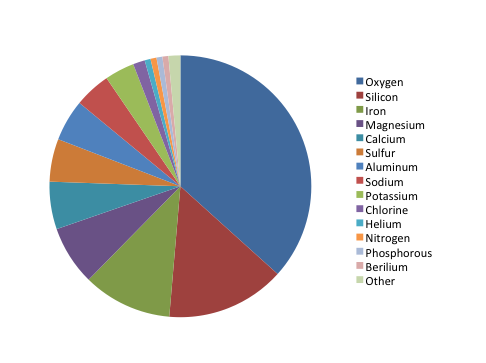
The chart shows the relative proportion of fifteen elements in Martian soil, listed in order from “most” to “least”: oxygen, silicon, iron, magnesium, calcium, sulfur, aluminum, sodium, potassium, chlorine, helium, nitrogen, phosphorus, beryllium, and other. Oxygen makes up about ⅓ of the composition, while silicon and iron together make up about ¼. The remaining slices make up smaller proportions, but the percentages aren’t listed in the key and are difficult to estimate. It is also hard to distinguish fifteen colors when comparing the pie chart to the color coded key.
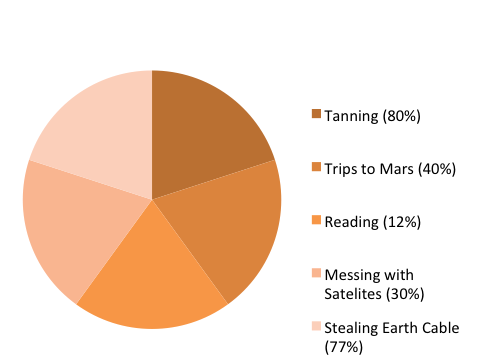
The chart shows the relative proportion of five leisure activities of Venusian teenagers (tanning, trips to Mars, reading, messing with satellites, and stealing Earth cable). Although each of the five slices are about the same size (roughly 20% of the total), the percentage of Venusian teenagers engaging in each activity varies widely (tanning: 80%, trips to Mars: 40%, reading: 12%, messing with satellites: 30%, stealing Earth cable: 77%). Therefore, there is a mismatch between the labels and the actual proportion represented by each activity (in other words, if reading represents 12% of the total, its slice should take up 12% of the pie chart area), which makes the representation inaccurate. In addition, the labels for the five slices add up to 239% (rather than 100%), which makes it impossible to accurately represent this dataset using a pie chart.
Bar graphs are also used to display proportions. In particular, they are useful for showing the relationship between independent and dependent variables, where the independent variables are discrete (often nominal) categories. Some examples are occupation, gender, and species. Bar graphs can be vertical or horizontal. In a vertical bar graph the independent variable is shown on the x axis (left to right) and the dependent variable on the y axis (up and down). In a horizontal one, the dependent variable will be shown on the horizontal (x) axis, the independent on the vertical (y) axis. The scale and origin of the graph should be meaningful. If the dependent (numeric) variable has a natural zero point, it is commonly used as a point of origin for the bar chart. However, zero is not always the best choice. You should experiment with both origin and scale to best show the relevant trends in your data without misleading the viewer in terms of the strength or extent of those trends.
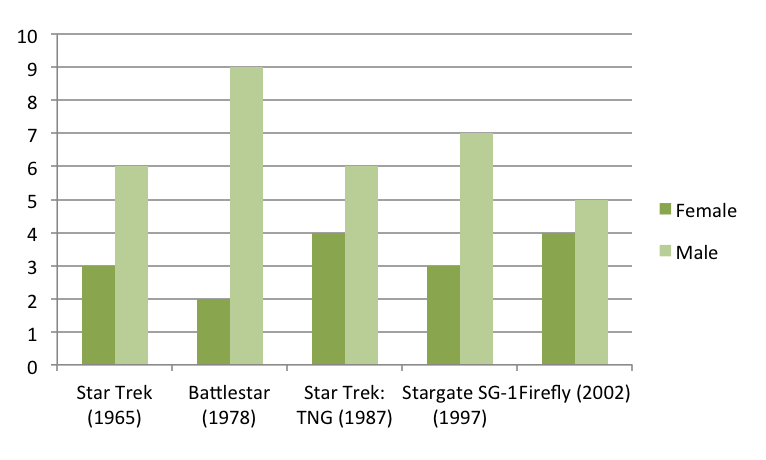
The graph shows the number of male and female spaceship crew members for five different popular television series: Star Trek (1965), Battlestar (1978), Star Trek: TNG (1987), Stargate SG-1 (1997), and Firefly (2002). Because the television series are arranged chronologically on the x-axis, the graph can also be used to look for trends in these numbers over time.
Although the number of crew members for each show is similar (ranging from 9 to 11), the proportion of female and male crew members varies. Star Trek has half as many female crew members as male crew members (3 and 6, respectively), Battlestar has fewer than one-fourth as many female crew members as male crew members (2 and 9, respectively), Star Trek: TNG has four female crew members and six male crew members, Stargate SG-1 has less than one-half as many female crew members as male crew members (3 and 7, respectively), and Firefly has four female and five male crew members.
Frequency histograms/distributions
Frequency histograms are a special type of bar graph that show the relationship between independent and dependent variables, where the independent variable is continuous, rather than discrete. This means that each bar represents a range of values, rather than a single observation. The dependent variables in a histogram are always numeric, but may be absolute (counts) or relative (percentages). Frequency histograms are good for describing populations—examples include the distribution of exam scores for students in a class or the age distribution of the people living in Chapel Hill. You can experiment with bar ranges (also known as “bins”) to achieve the best level of detail, but each range or bin should be of uniform width and clearly labeled.
XY scatter plots
Scatter plots are another way to illustrate the relationship between two variables. In this case, data are displayed as points in an x,y coordinate system, where each point represents one observation along two axes of variation. Often, scatter plots are used to illustrate correlation between two variables—as one variable increases, the other increases (positive correlation) or decreases (negative correlation). However, correlation does not necessarily imply that changes in one variable cause changes in the other. For instance, a third, unplotted variable may be causing both. In other words, scatter plots can be used to graph one independent and one dependent variable, or they can be used to plot two independent variables. In cases where one variable is dependent on another (for example, height depends partly on age), plot the independent variable on the horizontal (x) axis, and the dependent variable on the vertical (y) axis. In addition to correlation (a linear relationship), scatter plots can be used to plot non-linear relationships between variables.
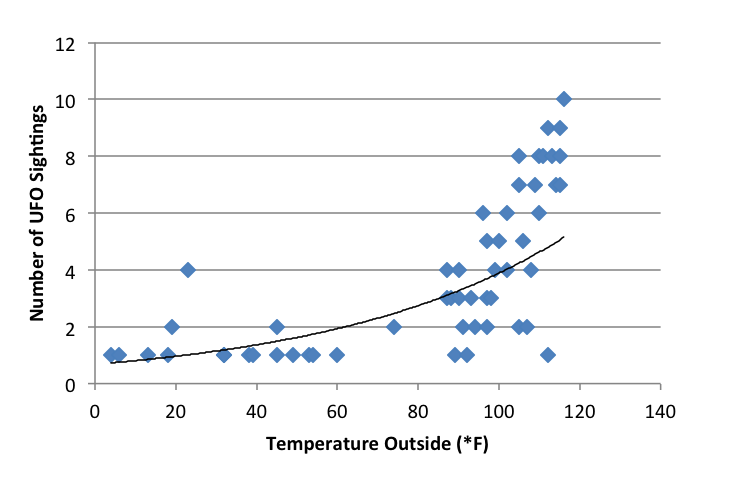
The scatter plot shows the relationship between temperature (x-axis, independent variable) and the number of UFO sightings (y-axis, dependent variable) for 53 separate data points. The temperature ranges from about 0°F and 120°F, and the number of UFO sightings ranges from 1 to 10. The plot shows a low number of UFO sightings (ranging from 1 to 4) at temperatures below 80°F and a much wider range of the number of sightings (from 1 to 10) at temperatures above 80°F. It appears that the number of sightings tends to increase as temperature increases, though there are many cases where only a few sightings occur at high temperatures.
XY line graphs
Line graphs are similar to scatter plots in that they display data along two axes of variation. Line graphs, however, plot a series of related values that depict a change in one variable as a function of another, for example, world population (dependent) over time (independent). Individual data points are joined by a line, drawing the viewer’s attention to local change between adjacent points, as well as to larger trends in the data. Line graphs are similar to bar graphs, but are better at showing the rate of change between two points. Line graphs can also be used to compare multiple dependent variables by plotting multiple lines on the same graph.
Example of an XY line graph:
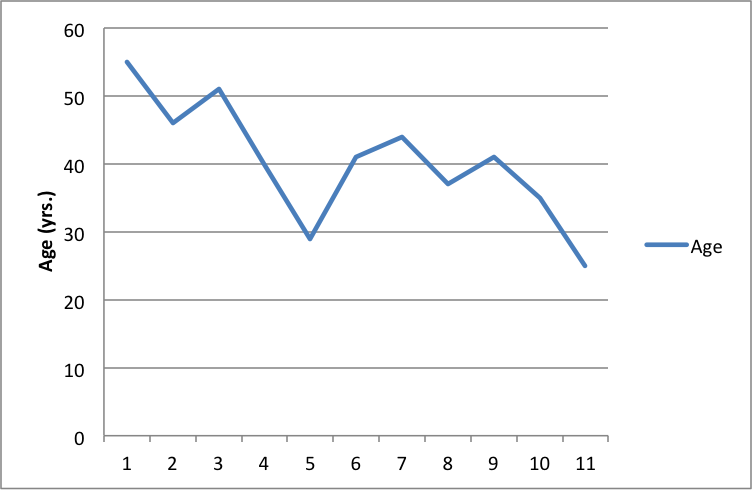
The line graph shows the age (in years) of the actor of each Doctor Who regeneration for the first through the eleventh regeneration. The ages range from a maximum of about 55 in the first regeneration to a minimum of about 25 in the eleventh regeneration. There is a downward trend in the age of the actors over the course of the eleven regenerations.
General tips for graphs
Strive for simplicity. Your data will be complex. Don’t be tempted to convey the complexity of your data in graphical form. Your job (and the job of your graph) is to communicate the most important thing about the data. Think of graphs like you think of paragraphs—if you have several important things to say about your data, make several graphs, each of which highlights one important point you want to make.
Strive for clarity. Make sure that your data are portrayed in a way that is visually clear. Make sure that you have explained the elements of the graph clearly. Consider your audience. Will your reader be familiar with the type of figure you are using (such as a boxplot)? If not, or if you’re not sure, you may need to explain boxplot conventions in the text. Avoid “chartjunk.” Superfluous elements just make graphs visually confusing. Your reader does not want to spend 15 minutes figuring out the point of your graph.
Strive for accuracy. Carefully check your graph for errors. Even a simple graphical error can change the meaning and interpretation of the data. Use graphs responsibly. Don’t manipulate the data so that it looks like it’s saying something it’s not—savvy viewers will see through this ruse, and you will come off as incompetent at best and dishonest at worst.
How should tables and figures interact with text?
Placement of figures and tables within the text is discipline-specific. In manuscripts (such as lab reports and drafts) it is conventional to put tables and figures on separate pages from the text, as near as possible to the place where you first refer to it. You can also put all the figures and tables at the end of the paper to avoid breaking up the text. Figures and tables may also be embedded in the text, as long as the text itself isn’t broken up into small chunks. Complex raw data is conventionally presented in an appendix. Be sure to check on conventions for the placement of figures and tables in your discipline.
You can use text to guide the reader in interpreting the information included in a figure, table, or graph—tell the reader what the figure or table conveys and why it was important to include it.
When referring to tables and graphs from within the text, you can use:
- Clauses beginning with “as”: “As shown in Table 1, …”
- Passive voice: “Results are shown in Table 1.”
- Active voice (if appropriate for your discipline): “Table 1 shows that …”
- Parentheses: “Each sample tested positive for three nutrients (Table 1).”
Works consulted
We consulted these works while writing this handout. This is not a comprehensive list of resources on the handout’s topic, and we encourage you to do your own research to find additional publications. Please do not use this list as a model for the format of your own reference list, as it may not match the citation style you are using. For guidance on formatting citations, please see the UNC Libraries citation tutorial . We revise these tips periodically and welcome feedback.
American Psychological Association. 2010. Publication Manual of the American Psychological Association . 6th ed. Washington, DC: American Psychological Association.
Bates College. 2012. “ Almost everything you wanted to know about making tables and figures.” How to Write a Paper in Scientific Journal Style and Format , January 11, 2012. http://abacus.bates.edu/~ganderso/biology/resources/writing/HTWtablefigs.html.
Cleveland, William S. 1994. The Elements of Graphing Data , 2nd ed. Summit, NJ: Hobart Press..
Council of Science Editors. 2014. Scientific Style and Format: The CSE Manual for Authors, Editors, and Publishers , 8th ed. Chicago & London: University of Chicago Press.
University of Chicago Press. 2017. The Chicago Manual of Style , 17th ed. Chicago & London: University of Chicago Press.
You may reproduce it for non-commercial use if you use the entire handout and attribute the source: The Writing Center, University of North Carolina at Chapel Hill
Make a Gift
Purdue Online Writing Lab Purdue OWL® College of Liberal Arts
Organizing Your Analysis

Welcome to the Purdue OWL
This page is brought to you by the OWL at Purdue University. When printing this page, you must include the entire legal notice.
Copyright ©1995-2018 by The Writing Lab & The OWL at Purdue and Purdue University. All rights reserved. This material may not be published, reproduced, broadcast, rewritten, or redistributed without permission. Use of this site constitutes acceptance of our terms and conditions of fair use.
There is no one perfect way to organize a rhetorical analysis essay. In fact, writers should always be a bit leery of plug-in formulas that offer a perfect essay format. Remember, organization itself is not the enemy, only organization without considering the specific demands of your particular writing task. That said, here are some general tips for plotting out the overall form of your essay.
Introduction
Like any rhetorical analysis essay, an essay analyzing a visual document should quickly set the stage for what you’re doing. Try to cover the following concerns in the initial paragraphs:
- Make sure to let the reader know you’re performing a rhetorical analysis. Otherwise, they may expect you to take positions or make an evaluative argument that may not be coming.
- Clearly state what the document under consideration is and possibly give some pertinent background information about its history or development. The intro can be a good place for a quick, narrative summary of the document. The key word here is “quick, for you may be dealing with something large (for example, an entire episode of a cartoon like the Simpsons). Save more in-depth descriptions for your body paragraph analysis.
- If you’re dealing with a smaller document (like a photograph or an advertisement), and copyright allows, the introduction or first page is a good place to integrate it into your page.
- Give a basic run down of the rhetorical situation surrounding the document: the author, the audience, the purpose, the context, etc.
Thesis Statements and Focus
Many authors struggle with thesis statements or controlling ideas in regards to rhetorical analysis essays. There may be a temptation to think that merely announcing the text as a rhetorical analysis is purpose enough. However, especially depending on your essay’s length, your reader may need a more direct and clear statement of your intentions. Below are a few examples.
1. Clearly narrow the focus of what your essay will cover. Ask yourself if one or two design aspects of the document is interesting and complex enough to warrant a full analytical treatment.
The website for Amazon.com provides an excellent example of alignment and proximity to assist its visitors in navigating a potentially large and confusing amount of information.
2. Since visual documents often seek to move people towards a certain action (buying a product, attending an event, expressing a sentiment), an essay may analyze the rhetorical techniques used to accomplish this purpose. The thesis statement should reflect this goal.
The call-out flyer for the Purdue Rowing Team uses a mixture of dynamic imagery and tantalizing promises to create interest in potential, new members.
3. Rhetorical analysis can also easily lead to making original arguments. Performing the analysis may lead you to an argument; or vice versa, you may start with an argument and search for proof that supports it.
A close analysis of the female body images in the July 2007 issue of Cosmopolitan magazine reveals contradictions between the articles’ calls for self-esteem and the advertisements’ unrealistic, beauty demands.
These are merely suggestions. The best measure for what your focus and thesis statement should be the document itself and the demands of your writing situation. Remember that the main thrust of your thesis statement should be on how the document creates meaning and accomplishes its purposes. The OWl has additional information on writing thesis statements.
Analysis Order (Body Paragraphs)
Depending on the genre and size of the document under analysis, there are a number of logical ways to organize your body paragraphs. Below are a few possible options. Which ever you choose, the goal of your body paragraphs is to present parts of the document, give an extended analysis of how that part functions, and suggest how the part ties into a larger point (your thesis statement or goal).
Chronological
This is the most straight-forward approach, but it can also be effective if done for a reason (as opposed to not being able to think of another way). For example, if you are analyzing a photo essay on the web or in a booklet, a chronological treatment allows you to present your insights in the same order that a viewer of the document experiences those images. It is likely that the images have been put in that order and juxtaposed for a reason, so this line of analysis can be easily integrated into the essay.
Be careful using chronological ordering when dealing with a document that contains a narrative (i.e. a television show or music video). Focusing on the chronological could easily lead you to plot summary which is not the point of a rhetorical analysis.
A spatial ordering covers the parts of a document in the order the eye is likely to scan them. This is different than chronological order, for that is dictated by pages or screens where spatial order concerns order amongst a single page or plane. There are no unwavering guidelines for this, but you can use the following general guidelines.
- Left to right and top to down is still the normal reading and scanning pattern for English-speaking countries.
- The eye will naturally look for centers. This may be the technical center of the page or the center of the largest item on the page.
- Lines are often used to provide directions and paths for the eye to follow.
- Research has shown that on web pages, the eye tends to linger in the top left quadrant before moving left to right. Only after spending a considerable amount of time on the top, visible portion of the page will they then scroll down.
Persuasive Appeals
The classic, rhetorical appeals are logos, pathos, and ethos. These concepts roughly correspond to the logic, emotion, and character of the document’s attempt to persuade. You can find more information on these concepts elsewhere on the OWL. Once you understand these devices, you could potentially order your essay by analyzing the document’s use of logos, ethos, and pathos in different sections.
The conclusion of a rhetorical analysis essay may not operate too differently from the conclusion of any other kind of essay. Still, many writers struggle with what a conclusion should or should not do. You can find tips elsewhere on the OWL on writing conclusions. In short, however, you should restate your main ideas and explain why they are important; restate your thesis; and outline further research or work you believe should be completed to further your efforts.
How to Write an Analysis Essay: Examples + Writing Guide
An analysis / analytical essay is a standard assignment in college or university. You might be asked to conduct an in-depth analysis of a research paper, a report, a movie, a company, a book, or an event. In this article, you’ll find out how to write an analysis paper introduction, thesis, main body, and conclusion, and analytical essay example.
So, what is an analytical essay? This type of assignment implies that you set up an argument and analyze it using a range of claims. The claims should be supported by appropriate empirical evidence. Note that you need to explore both the positive and negative sides of the issue fully.
Analytical skills are the key to getting through your academic career. Moreover, they can be useful in many real-life situations. Keep reading this article by Custom-writing experts to learn how to write an analysis!
❓ What Is an Analytical Essay?
- 🤔 Getting Started
📑 Analytical Essay Outline
- 📔 Choosing a Title
- 💁 Writing an Introduction
- 🏋 Writing a Body
- 🏁 Writing a Conclusion
🔗 References
Before you learn how to start an analysis essay, you should understand some fundamentals of writing this type of paper. It implies that you analyze an argument using a range of claims supported by facts . It is essential to understand that in your analysis essay, you’ll need to explore the negative sides of the issue and the positive ones. That’s what distinguishes an analytical essay from, say, a persuasive one.

These are the steps to write an academic paper :
- Review the literature . Before starting any paper, you should familiarize yourself with what has already been written in the field. And the analytical essay is no exception. The easiest way is to search on the web for the information.
- Brainstorm ideas. After you’ve done your search, it is time for a brainstorm! Make a list of topics for your analysis essay, and then choose the best one. Generate your thesis statement in the same way.
- Prepare an outline . Now, when you’ve decided on the topic and the thesis statement of your analytical essay, think of its structure. Below you will find more detailed information on how your paper should be structured.
- Write the first draft. You’ve done a lot of work by now. Congratulations! Your next goal is to write the first version of your analysis essay, using all the notes that you have. Remember, you don’t need to make it perfect!
- Polish your draft. Now take your time to polish and edit your draft to transform it into the paper’s final version.
You are usually assigned to analyze an article, a book, a movie, or an event. If you need to write your analytical essay on a book or an article, you’ll have to analyze the style of the text, its main points, and the author’s purported goals.
🤔 Analytical Essay: Getting Started
The key to writing an analysis paper is to choose an argument that you will defend throughout it. For example: maybe you are writing a critical analysis paper on George Orwell’s Animal Farm The first and imperative task is to think about your thesis statement. In the case of Animal Farm , the argument could be:
In Orwell’s Animal Farm , rhetoric and language prove to be more effective ways to keep social control than physical power.
The University of North Carolina at Chapel Hill gives a great explanation of the thesis statement , how to create one, and what its function is.
But that’s not all. Once you have your thesis statement, you need to break down how you will approach your analysis essay to prove your thesis. To do this, follow these steps:
- Define the main goal(s) of your analysis . Remember that it is impossible to address each and every aspect in a single paper. Know your goal and focus on it.
- Conduct research , both online and offline, to clarify the issue contained within your thesis statement.
- Identify the main parts of the issue by looking at each part separately to see how it works.
- Try to clearly understand how each part works.
- Identify the links between the various aspects of the topic .
- By using the information you found, try to solve your main problem .
At this point, you should have a clear understanding of both the topic and your thesis statement. You should also have a clear direction for your analysis paper firmly planted in your mind and recorded in writing.
This will give you what you need to produce the paper’s outline.
An outline is the starting point for your work. A typical analytical essay features the usual essay structure. A 500-word essay should consist of a one-paragraph introduction, a three-paragraph body, and a one-paragraph conclusion. Find below a great analytical essay outline sample. Feel free to use it as an example when doing your own work!
Analysis Essay: Introduction
- Start with a startling statement or provocative question.
“All animals are equal, but some animals are more equal”. Animal Farm abounds in ironic and provocative phrases to start an analytical essay.
- Introduce the work and its author.
- Give background information that would help the reader understand your opinion.
- Formulate a thesis statement informing the reader about the purpose of the essay. Essay format does not presuppose telling everything possible on the given topic. Thus, a thesis statement tells what you are going to say, implying what you will not discuss, establishing the limits.
In Animal Farm, Orwell uses different irony types to ridicule totalitarianism to manifest its inability to make every member of society equal and happy.
Analysis Essay: Body
The analytical essay structure requires 2-3 developmental paragraphs, each dedicated to one separate idea confirming your thesis statement. The following template should be used for each of the body paragraphs.
- Start with a topic sentence that supports an aspect of your thesis.
Dramatic irony is used in Animal Farm to point out society’s ignorance.
- Continue with textual evidence (paraphrase, summary, direct quotations, specific details). Use several examples that substantiate the topic sentence.
Animals are unaware of the fact that Boxer was never sent to the hospital. He was sent to the slaughterhouse. However, the reader and writer understand that this is a lie.
- Conclude with an explanation.
By allowing the readers to learn some essential facts before the characters, dramatic irony creates suspense and shows how easy it is to persuade and manipulate the public.
Analysis Essay Conclusion
The next four points will give you a short instruction on how to conclude an analytical essay.
- Never use new information or topics here.
- Restate your thesis in a different formulation.
- Summarize the body paragraphs.
- Comment on the analyzed text from a new perspective.
📔 Choosing a Title for Your Analysis Essay
Choosing a title seems like not a significant step, but it is actually very important. The title of your critical analysis paper should:
- Entice and engage the reader
- Be unique and capture the readers’ attention
- Provide an adequate explanation of the content of the essay in just a few carefully chosen words
In the Animal Farm example, your title could be:
“How Do the Pigs Manage to Keep Social Control on Animal Farm?”
Analysis Essay Topics
- Analyze the media content.
- Analyze the specifics and history of hip-hop culture.
- Sociological issues in the film Interstellar .
- Discuss the techniques M. Atwood uses to describe social issues in her novel The Handmaid’s Tale .
- Compare and analyze the paintings of Van Gogh and George Seurat.
- Analysis of Edgar Allan Poe’s The Black Cat .
- Examine the juvenile crime rates.
- Describe the influence of different parenting styles on children’s mind.
- Analyze the concept of the Ship of Theseus .
- Compare and analyze the various views on intelligence .
- Analysis of The Yellow Wallpaper by Charlotte Perkins Gilman .
- Discuss the techniques used by W. Shakespeare in A Midsummer Night’s Dream .
- Analyze the biography of Frederic Chopin .
- Manifestation of the Chicano culture in the artwork An Ofrenda for Dolores del Rio .
- Similarities and differences of Roman, Anglo-Saxon, and Spanish Empires .
- Describe the problem of stalking and its impact on human mental health.
- Examine the future of fashion .
- Analyze the topicality of the article Effectiveness of Hand Hygiene Interventions in Reducing Illness Absence .
- Discuss Thomas Paine’s impact on the success of American revolution.
- Meaningful messages in Recitatif by Toni Morrison .
- Explore the techniques used by directors in the film Killing Kennedy .
- Compare the leadership styles of Tang Empress Wu Zetian and the Pharaoh Cleopatra .
- Evaluate the credibility of Kristof’s arguments in his article Remote Learning Is Often an Oxymoron.
- Analyze genetically modified food.
- Examine the influence of Europeans on Indian tribes in The Narrative of the Captivity and Restoration of Mrs. Mary Rowlandson .
- Describe the rhetoric techniques used in The Portrait of Dorian Gray by Oscar Wilde .
- The importance of fighting against violence in communities in the documentary film The Interrupters .
- Analyze indoor and outdoor pollution.
- Analyze the issue of overprotective parenthood .
- Explore the connection between eating habits and advertisement.
- Discuss the urgence of global warming issue.
- Influence of sleep on people’s body and mental health.
- Analyze the relationship between Christianity and sports .
- Discuss the concept of leadership and its significance for company efficiency.
- Analyze the key lessons of the book Rich Dad Poor Dad by Robert Kiyosaki.
- Examine the specifics of nursing ethic.
- The theme of emotional sufferings in the short story A Rose for Emily .
- Analysis of bias in books for children .
- Analyze the rhetoric of the article Public Monuments .
- Describe the main messages in Jean-Paul Sartre’s Nausea .
- Explore the problem of structural racism in healthcare.
- The reasons of tango dance popularity.
- The shortcomings of the American educational system in Waiting for Superman.
- Analyze and compare Erin’s Law and Megan’s Law.
- Analyze the James Madison’s essay Federalist 10 .
- Examine symbols in the movie The Joker.
- Compare the thematic connection and stylistic devices in the poems The Road Not Taken and Find Your Way .
- Describe and analyze the life of Eddie Bernice Johnson.
- Explore the social classes in America.
- Crucial strengths and weaknesses of the main translation theories .
💁 Writing Your Analytical Essay Introduction
You must understand how to compose an introduction to an analysis paper. The University of Wollongong describes the introduction as a “map” of any writing. When writing the introduction, follow these steps:
- Provide a lead-in for the reader by offering a general introduction to the topic of the paper.
- Include your thesis statement , which shifts the reader from the generalized introduction to the specific topic and its related issues to your unique take on the essay topic.
- Present a general outline of the analysis paper.
Watch this great video for further instructions on how to write an introduction to an analysis essay.
Example of an Analytical Essay Introduction
“Four legs good, two legs bad” is one of the many postulates invented by George Orwell for his characters in Animal Farm to vest them with socialist ideology and control over the animal population. The social revolution on Manor Farm was built on language instruments, first for the collective success of the animals, and later for the power consolidation by the pigs. The novel was written in 1945 when the transition from limitless freedoms of socialist countries transformed into dictatorship. Through his animal protagonists, the author analyzes the reasons for peoples’ belief in the totalitarian regime. In Orwell’s Animal Farm , rhetoric and language prove to be more effective ways to keep social control than physical power.
🏋 Writing Your Analytical Essay Body
The body of the paper may be compared to its heart. This is the part where you show off your talent for analysis by providing convincing, well-researched, and well-thought-out arguments to support your thesis statement. You have already gathered the information, and now all you may start crafting your paper.
To make the body of an analytical essay, keep the following in mind:
- Discuss one argument per paragraph , although each argument can relate to multiple issues
- Strike a balance between writing in an unbiased tone, while expressing your personal opinion
- Be reasonable when making judgments regarding any of the problems you discuss
- Remember to include the opposing point of view to create a balanced perspective
The bottom line is: you want to offer opposing views, but you must pose your arguments so they will counter those opposing views and prove your point of view. Follow these steps when constructing each body paragraph:
- Choose the main sentence. The main or topic sentence will be the first line in your essay. The topic sentence is responsible for presenting the argument you will discuss in the paragraph and demonstrate how this argument relates to the thesis statement.
- Provide the context for the topic sentence , whether it relates to a quote, a specific incident in society, or something else. Offer evidence on who, what, where, when, why, and how.
- Give your analysis of the argument and how it adequately proves your thesis.
- Write a closing sentence that sums up the paragraph and provides a transition to the following paragraph.
Example of an Analytical Essay Body
Literacy can grant power, provided that there are animals who cannot read or write. In the beginning, the animals’ literacy and intellect are relatively the same. Old Major is the cleverest pig; he is the kind old philosopher, like Karl Marx or Vladimir Lenin. During his retirement, he develops a theory that all humans are the root of evil. His speech was the foundation for the pigs’ assumption of power. They refined his ideas into a new ideology and called it Animalism. They also learned how to read. It allowed the pigs to declare themselves the “mind workers.” Therefore, the pigs’ literacy assured the illiterate animals in their objective superiority.
Meanwhile, as the pigs were the intellectual elite, they were not supposed to work, which raised their social status by itself. Snowball tried to promote education among all the animals, but most of them failed to master the alphabet. This is a metaphor for the general public being predominantly ignorant and easy to manipulate. At the same time, Boxer and other animals that spend most of the day in hard work merely have no time to develop their intellect. Thus, the pigs’ intention to build a school for pig children was highly efficient. Unequal access to education and unequal ability to express one’s thoughts in perspective reinforce the social divide, making the pigs smarter and more powerful and undermining other animals’ self-esteem.
At this point, the pigs resort to propaganda and rhetoric. Squealer uses his oratorical gift to refine the pigs’ message to the other animals. Upon Napoleon’s order, he breaks the Seven Commandments of farm governance. At night, he climbs the ladder to change them, and once even falls from the ladder trying to change the commandment on alcohol. The “proletarian” animals soon forget what the Seven Commandments were like in the first place and are unsure if they have ever been altered. Further on, Minimus writes a poem praising Napoleon. Finally, Squealer replaces the Commandments with a single assertion: “All animals are equal, but some animals are more equal than others.” Language is no longer used to convince. It is used to control and manipulate.
🏁 Writing Your Analytical Essay Conclusion
The conclusion is short and sweet. It summarizes everything you just wrote in the essay and wraps it up with a beautiful shiny bow. Follow these steps to write a convincing conclusion:
- Repeat the thesis statement and summarize your argument. Even when using the best summary generator for the task, reread it to make sure all the crucial points are included.
- Take your argument beyond what is simply stated in your paper. You want to show how it is essential in terms of the bigger picture. Also, you may dwell on the influence on citizens of the country.
Example of an Analytical Essay Conclusion
Because of everything mentioned above, it becomes clear that language and rhetoric can rise to power, establish authority, and manipulate ordinary people. Animal Farm is the simplified version of a communist society. It shows how wise philosophers’ good intentions can be used by mean leaders to gain unopposed power and unconditional trust. Unfortunately, this can lead to the death of many innocent animals, i.e., people, as totalitarianism has nothing to do with people’s rule. Therefore, language and oratory are potent tools that can keep people oppressed and weak, deprive them of any chance for improvement and growth, and make them think that there is no other possible existence.
Now you are ready to write an analysis essay! See, it’s easier than you thought.
Of course, it’s always helpful to see other analysis essay examples. The University of Arkansas at Little Rock provides some great examples of an analytical paper .
✏️ Analysis Essay FAQ
A great analytical paper should be well-structured, cohesive, and logically consistent. Each part of the essay should be in its place, creating a smooth and easy-to-read text. Most importantly, the statements should be objective and backed by arguments and examples.
It is a paper devoted to analyzing a certain topic or subject. An analysis essay is all about reviewing certain details of the subject and interpreting them. For example, such an analysis for a poem includes a description of artistic means that helped the poet convey the idea.
Writing an analytical essay on a book/movie/poem start with an outline. Point out what catches the eye when reviewing the subject. See how these details can be interpreted. Make sure that you refer to the main idea/message. Add an appropriate introduction and a logical conclusion.
Being more analytical in writing can be essential for a student. This is a skill that can be self-taught: try to start noticing subtle details and describe them. As you write, interpret the facts and strive to draw conclusions. Try to be as objective as possible.
- Elements of Analysis
- How Can I Create Stronger Analysis?
- How to Write a Literary Analysis Essay: Bucks.edu
- Essay Structure | – Harvard College Writing Center
- Analytical Writing: Looking Closely (Colostate.edu)
- Analytical Thesis Statements – University of Arizona
- Writing an analytic essay – UTSC – University of Toronto
- Organizing Your Analysis // Purdue Writing Lab
- How to Write an Analytical Essay: 15 Steps (with Pictures)
- Share to Facebook
- Share to Twitter
- Share to LinkedIn
- Share to email

A film analysis essay might be the most exciting assignment you have ever had! After all, who doesn’t love watching movies? You have your favorite movies, maybe something you watched years ago, perhaps a classic, or a documentary. Or your professor might assign a film for you to make a...

A critique paper is an academic writing genre that summarizes and gives a critical evaluation of a concept or work. Or, to put it simply, it is no more than a summary and a critical analysis of a specific issue. This type of writing aims to evaluate the impact of...

What is a creative essay, if not the way to express yourself? Crafting such a paper is a task that allows you to communicate your opinion and tell a story. However, even using your imagination to a great extent doesn’t free you from following academic writing rules. Don’t even get...

A compare and contrast essay — what is it? In this type of paper, you compare two different things or ideas, highlighting what is similar between the two, and you also contrast them, highlighting what is different. The two things might be events, people, books, points of view, lifestyles, or...

What is an expository essay? This type of writing aims to inform the reader about the subject clearly, concisely, and objectively. The keyword here is “inform”. You are not trying to persuade your reader to think a certain way or let your own opinions and emotions cloud your work. Just stick to the...
![essay analysis chart example Short Story Analysis: How to Write It Step by Step [New]](https://custom-writing.org/blog/wp-content/uploads/2020/12/man-sits-end-trolltunga-before-mountains-284x153.jpg)
Have you ever tried to write a story analysis but ended up being completely confused and lost? Well, the task might be challenging if you don’t know the essential rules for literary analysis creation. But don’t get frustrated! We know how to write a short story analysis, and we are...

Have you ever tried to get somebody round to your way of thinking? Then you should know how daunting the task is. Still, if your persuasion is successful, the result is emotionally rewarding. A persuasive essay is a type of writing that uses facts and logic to argument and substantiate...
![essay analysis chart example Common Essay Mistakes—Writing Errors to Avoid [Updated]](https://custom-writing.org/blog/wp-content/uploads/2020/12/avoid-mistakes-ccw-284x153.jpg)
One of the most critical skills that students gain during their college years is assignment writing. Composing impressive essays and research papers can be quite challenging, especially for ESL students. Nonetheless, before learning the art of academic writing, you may make numerous common essay mistakes. Such involuntary errors appear in:...

You’re probably thinking: I’m no Mahatma Gandhi or Steve Jobs—what could I possibly write in my memoir? I don’t even know how to start an autobiography, let alone write the whole thing. But don’t worry: essay writing can be easy, and this autobiography example for students is here to show...
![essay analysis chart example Why I Want to Be a Teacher Essay: Writing Guide [2024]](https://custom-writing.org/blog/wp-content/uploads/2020/12/senior-male-professor-writing-blackboard-with-chalk3-284x153.jpg)
Some people know which profession to choose from childhood, while others decide much later in life. However, and whenever you come to it, you may have to elaborate on it in your personal statement or cover letter. This is widely known as “Why I Want to Be a Teacher” essay.
![essay analysis chart example Friendship Essay: Writing Guide & Topics on Friendship [New]](https://custom-writing.org/blog/wp-content/uploads/2020/12/smiley-female-friends-fist-bumping-284x153.jpg)
Assigned with an essay about friendship? Congrats! It’s one of the best tasks you could get. Digging through your memories and finding strong arguments for this paper can be an enjoyable experience. I bet you will cope with this task effortlessly as we can help you with the assignment. Just...

When you are assigned an autobiography to write, tens, and even hundreds of questions start buzzing in your head. How to write autobiography essay parts? What to include? How to make your autobiography writing flow? Don’t worry about all this and use the following three simple principles and 15 creative...
This resource helps me a lot. Thanks! You guys have great information. Do you think I can use these steps when taking a test? Could it be known as plagiarized if I just copy and paste the information?
Thanks, very good information.
Thanks for learning how to critique research papers in a proper way! This is what I need to cope with this task successfully! Thanks!
How much is an essay, and is there a chance it can be plagiarized?
Analytical Essay Guide
Analytical Essay Outline
How to Craft Analytical Essay Outline? An Easy Guide
10 min read
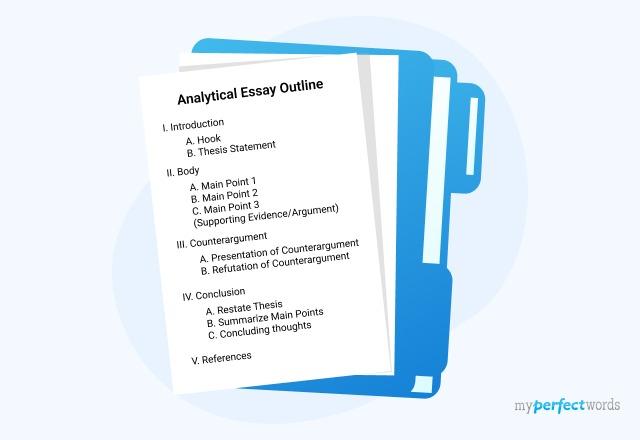
People also read
Analytical Essay Guide with Examples & Tips
Interesting Analytical Essay Topics Ideas for Students
15 Analytical Essay Samples to Learn From - Tips Included
Feeling a bit lost when it comes to writing an analytical essay and don't know how to structure the data?
Many students find it challenging to dissect a text, organize their thoughts, and structure their analysis essays effectively.
But don't worry; we've got your back! In our blog, we've put together some easy-to-follow templates and examples that will help you make a perfect analytical essay outline. No more staring at a blank page! With our tips and examples, you'll have a clear roadmap for your essay.
So, let's get started!
- 1. Analytical Essay Overview
- 2. How To Write An Analytical Essay Outline?
- 3. What is the Format of an Analytical Essay?
- 4. Analytical Essay Outline Samples
- 5. Tips to Structure an Analytical Essay
Analytical Essay Overview
An analytical essay is a type of academic writing that examines a topic, idea, or piece of literature in-depth. It involves breaking down the subject into its components, analyzing them, and presenting a well-structured argument or interpretation.
The goal of an analytical essay is to explore the "how" and "why" of the subject, rather than just describing it. Unlike an argumentative essay , an analytical does not include persuasion of the writer’s claim. It often requires evidence, critical thinking, and careful evaluation to support your thesis and provide insights.
This essay type is commonly assigned in literature, history, and other academic disciplines to assess your ability to think critically and articulate your ideas clearly.

Paper Due? Why Suffer? That's our Job
How To Write An Analytical Essay Outline?
Like every other academic writing, an analytical essay requires an organized structure for its content to be readable and understandable. In order to shape all the raw information, an outline is drafted.
An analytical essay outline is similar to the traditional essay outline of five paragraphs. Here are given the sections of a 5 paragraph analytical essay outline:
The researched information about the specific topic needs to be organized. This is to make sure that the content is clear and effective for the readers.
Read on to get a better idea of each section of the outline.

Analytical Essay Introduction
The importance and significance of the introduction of an essay can not be denied. An analytical essay introduction is the first section of the essay that sets the stage for analysis.
The purpose of writing an essay introduction is to attract the readers and motivate them to read the essay. The introduction lays the whole groundwork for your essay. So the more substantial the introduction is, the more effective the paper is going to be.
The analytical essay introduction is based on three main elements:
Background Information
- Thesis statement
A hook statement is an opening sentence of the introductory paragraph. Just as the name suggests, a writer uses a hook statement to “hook” the audience to read further.
A hook can take various forms, such as humor, statistics, questions, or anecdotes. Writers can select any type of opening sentence depending on the essay topic, provided it aligns with the theme and subject matter.
Example Hook:
Ready to write hooks that hook? Check out our ' hook examples' blog post and discover different types of powerful hooks!
Following the hook, provide some context about the topic being analyzed. This is where you bridge the gap between the general attention grabber and the specific argument you'll present in the thesis statement.
For Example:
Thesis Statement
Following the hook comes the most critical element of an essay - the thesis statement. A thesis statement is the writer’s stance or argument on the chosen work. This is where the writer states and highlights the main argument of the essay topic.
The thesis statement can be written by keeping in mind the original text’s goal and the writer’s analysis.
For example,
Analytical Essay Body Paragraphs
The body paragraphs of an essay support your claim by providing shreds of evidence. All the gathered and relevant information that justifies the argument is presented in this section.
The body of the analytical essay should be divided into different paragraphs. Discuss each point in a specific paragraph, making your essay organized and understandable for the reader.
All paragraphs in the body section should cover the following components:
- Topic Sentence - A topic sentence is an opening sentence of a paragraph. This sentence is the claim or the important point that proves the thesis statement. Begin each of your paragraphs with a topic sentence.
- Specific examples: Use concrete details, quotes, or scenes from the work you're analyzing.
- Data or statistics: If relevant, incorporate data or statistics to support your claims.
- Expert opinions: Opinions from credible sources can strengthen your analysis.
- Why is this evidence important?
- How does it illustrate the point you're making?
- What deeper meaning or insight does it reveal about the work being analyzed?
Note: Ea ch paragraph should be transitioned to make logical content. This transition will act as a bridge and will connect the previous paragraph with the next paragraph.
Analytical Essay Conclusion
The essay conclusion is the last section where all the discussion comes to an end. Here the writer restates the thesis statement and provides a short summary of the major points in the content. It will prove that the main argument is justified using the evidence for the readers.
For example,
What is the Format of an Analytical Essay?
When it comes to formatting your analytical essay, adhering to specific guidelines is essential to ensure a professional presentation and clarity for your readers. Here are some key formatting guidelines to follow:
- Page Setup: Use standard letter-sized (8.5" x 11") paper with 1-inch margins on all sides.
- Font: Select a legible font, such as Times New Roman or Arial, and maintain consistency throughout the document.
- Font Size: Use a 12-point font size for the main text to ensure readability.
- Spacing: Double-space the entire essay, including the title, headings, and references.
- Title Page: Include a title page with the essay title, your name, course, instructor's name, and date. This information is typically centered and formatted according to your institution's guidelines.
By adhering to these formatting guidelines, you'll present your work professionally, making it easier for readers to engage with your analysis.
Tough Essay Due? Hire Tough Writers!
Analytical Essay Outline Samples
An analytical essay is a little different than other types of essay . Therefore, to write a good analytical essay, students require essay examples to know what to produce and how to produce it.
We have some free analysis essay outline samples for you to take assistance for your next assignment. Let’s take a look:
Analytical Essay Structure Sample
Critical Analytical Essay Outline Template
Literary Analytical Essay Outline
Macbeth Analytical Essay
Analytical Essay Outline Worksheet
Analysis Essay Outline College
5 Paragraph Analytical Essay Outline
Need more analytical essay samples? Check out our “ analytical essay examples ” blog and get the ideas!
Tips to Structure an Analytical Essay
Here are some essential tips to help you create a well-organized and effective analytical essay:
- Choose a Clear Analytical Essay Topic: Select a specific topic or idea to analyze. Make sure it's something you can dissect and discuss thoroughly. If you are looking for ideas read our blog on analytical essay topics to get inspiration.
- Begin with an Analytical Essay Outline: Start with a clear outline to organize your thoughts. Use an outline example or sample as a template.
- Introduction with a Strong Thesis: Your introduction should introduce the topic and contain a strong thesis statement that lays out your argument.
- Use Evidence to Support Thesis: Dedicate individual paragraphs to supporting evidence and arguments. Use the analytical essay structure to create a logical flow.
- Cite Sources Properly: If you're using references, ensure you follow the analytical essay format and cite sources correctly.
- Analyze and Interpret: Analyze text in detail and provide insights and interpretations.
- Conclusion with Restated Thesis: Summarize your main points and restate the thesis in the conclusion.
- Edit and Proofread: Review and edit your essay for clarity and coherence.
By following these tips and employing an analytical argument essay outline, you'll structure your essay for maximum impact.
In summary, we've covered the ins and outs of creating an analytical essay outline in our guide. With this, you should feel more confident in structuring your essays effectively. Remember, a well-structured outline is your dependable guide for successful essay writing so create one wisely!
If you're searching to get professional help, our analytical essay writing service is the answer. We provide free samples and custom essay help to guide you for all your academic assignments.
Our essay writing service is affordable and ensures top academic quality.
Simply place your " write essay for me " request to get help from a qualified and experienced analytical essay writer.
Frequently Asked Questions
What is the formula for an analytical essay.
The formula for an analytical essay typically involves introducing a thesis statement, providing evidence to support the thesis, and analyzing that evidence to draw conclusions.
What is the outline of an analytical paragraph?
The outline of an analytical paragraph often includes a topic sentence introducing the main point, followed by evidence or examples to support that point, and analysis or interpretation of the evidence to connect it back to the thesis.
What are the three major parts of an analysis essay?
The three major parts of an analysis essay are the introduction, body paragraphs, and conclusion. The introduction sets up the thesis and provides context for the analysis. The body paragraphs present evidence and analysis to support the thesis. The conclusion summarizes the main points and restates the thesis in light of the analysis provided.

Write Essay Within 60 Seconds!

Nova Allison is a Digital Content Strategist with over eight years of experience. Nova has also worked as a technical and scientific writer. She is majorly involved in developing and reviewing online content plans that engage and resonate with audiences. Nova has a passion for writing that engages and informs her readers.

Paper Due? Why Suffer? That’s our Job!
Keep reading
-9391.jpg&w=828&q=75)
How to Write a Character Analysis Essay

A character analysis essay is a challenging type of essay students usually write for literature or English courses. In this article, we will explain the definition of character analysis and how to approach it. We will also touch on how to analyze characters and guide you through writing character analysis essays.
Typically, this kind of writing requires students to describe the character in the story's context. This can be fulfilled by analyzing the relationship between the character in question and other personas. Although, sometimes, giving your personal opinion and analysis of a specific character is also appropriate.
Let's explain the specifics of how to do a character analysis by getting straight to defining what is a character analysis. Our term paper writers will have you covered with a thorough guide!
What Is a Character Analysis Essay?
The character analysis definition explains the in-depth personality traits and analyzes characteristics of a certain hero. Mostly, the characters are from literature, but sometimes other art forms, such as cinematography. In a character analysis essay, your main job is to tell the reader who the character is and what role they play in the story. Therefore, despite your personal opinion and preferences, it is really important to use your critical thinking skills and be objective toward the character you are analyzing. A character analysis essay usually involves the character's relationship with others, their behavior, manner of speaking, how they look, and many other characteristics.
Although it's not a section about your job experience or education on a resume, sometimes it is appropriate to give your personal opinion and analysis of a particular character.
What Is the Purpose of a Character Analysis Essay
More than fulfilling a requirement, this type of essay mainly helps the reader understand the character and their world. One of the essential purposes of a character analysis essay is to look at the anatomy of a character in the story and dissect who they are. We must be able to study how the character was shaped and then learn from their life.
A good example of a character for a character analysis essay is Daisy Buchanan from 'The Great Gatsby.' The essay starts off by explaining who Daisy is and how she relates to the main character, Jay Gatsby. Depending on your audience, you need to decide how much of the plot should be included. If the entire class writes an essay on Daisy Buchanan, it is logical to assume everyone has read the book. Although, if you know for certain that your audience has little to no knowledge of who she is, it is crucial to include as much background information as possible.
After that, you must explain the character through certain situations involving her and what she said or did. Make sure to explain to the reader why you included certain episodes and how they have showcased the character. Finally, summarize everything by clearly stating the character's purpose and role in the story.
We also highly recommend reading how to write a hook for an essay .
Still Need Help with Your Character Analysis Essay?
Different types of characters.
To make it clear how a reader learns about a character in the story, you should note that several characters are based on their behaviors, traits, and roles within a story. We have gathered some of them, along with vivid examples from famous literature and cinema pieces:

Types of Characters
- Major : These are the main characters; they run the story. Regularly, there are only one or two major characters. Major characters are usually of two types: the protagonist – the good guy, and the antagonist: the bad guy or the villain.
- Protagonist (s) (heroes): The main character around whom most of the plot revolves.
For example, Othello from Shakespeare's play, Frodo from The Lord of the Rings by J.R.R. Tolkien, Harry Potter from the Harry Potter series by J.K. Rowling, and Elizabeth Bennet from 'Pride and Prejudice' by Jane Austen.
- Antagonist (s): This is the person that is in opposition to the protagonist. This is usually the villain, but it could also be a natural power, set of circumstances, majestic being, etc.
For example, Darth Vader from the Star Wars series by George Lucas, King Joffrey from Game of Thrones, or the Wicked Queen from 'Snow White and Seven Dwarfs.'
- Minor : These characters help tell the major character's tale by letting them interact and reveal their personalities, situations, and/or stories. They are commonly static (unchanging). The minor characters in The Lord of the Rings by J.R.R. Tolkien would be the whole Fellowship of the ring. In their own way, each member of the Fellowship helps Frodo get the ring to Mordor; without them, the protagonist would not be a protagonist and would not be able to succeed. In the Harry Potter series by J.K. Rowling, minor characters are Ronald Weasley and Hermione Granger. They consistently help Harry Potter on his quests against Voldemort, and, like Frodo, he wouldn't have succeeded without them.
On top of being categorized as a protagonist, antagonist, or minor character, a character can also be dynamic, static, or foil.
- Dynamic (changing): Very often, the main character is dynamic.
An example would also be Harry Potter from the book series by J.K. Rowling. Throughout the series, we see Harry Potter noticing his likeness to Voldemort. Nevertheless, Harry resists these traits because, unlike Voldemort, he is a good person and resists any desire to become a dark wizard.
- Static (unchanging): Someone who does not change throughout the story is static.
A good example of a static character is Atticus Finch from “How to Kill a Mockingbird” by Harper Lee. His character and views do not change throughout the book. He is firm and steady in his beliefs despite controversial circumstances.
- Foils : These characters' job is to draw attention to the main character(s) to enhance the protagonist's role.
A great example of a foil charact e r is Dr. Watson from the Sherlock Holmes series by Arthur Conan Doyle.
How to Analyze a Character
While preparing to analyze your character, make sure to read the story carefully.
- Pay attention to the situations where the character is involved, their dialogues, and their role in the plot.
- Make sure you include information about what your character achieves on a big scale and how they influence other characters.
- Despite the categories above, try thinking outside the box and explore your character from around.
- Avoid general statements and being too basic. Instead, focus on exploring the complexities and details of your character(s).
How to Write a Character Analysis Essay?
To learn how to write a character analysis essay and gather a more profound sense of truly understanding these characters, one must completely immerse themself in the story or literary piece.
- Take note of the setting, climax, and other important academic parts.
- You must be able to feel and see through the characters. Observe how analysis essay writer shaped these characters into life.
- Notice how little or how vast the character identities were described.
- Look at the characters' morals and behaviors and how they have affected situations and other characters throughout the story.
- Finally, observe the characters whom you find interesting.
Meanwhile, if you need help writing a paper, leave us a message ' write my paper .'
How Do You Start a Character Analysis Essay
When writing a character analysis essay, first, you have to choose a character you'd like to write about. Sometimes a character will be readily assigned to you. It's wise to consider characters who play a dynamic role in the story. This will captivate the reader as there will be much information about these personas.
Read the Story
You might think that if you already have read the book, there is no need to do so again; however, now that you know the character you would like to focus on, reading it again will have plenty of benefits. It will give you an opportunity to be more precise while reading the scenes that relate directly to your character and are important for his/her analysis. While reading the book, pay attention to every tiny detail to make sure you grasp the whole array of your character's traits.
Consider the following things:
- What specific descriptions does the author provide for each character?
For example, when J.K. Rowling describes Harry Potter for the first time, she describes his clothes as old and oversized, his hair untidy, and his glasses as broken. It might seem just like a simple description, but she expresses compassion and pity for an orphan neglected by his only relatives.
- What kinds of relationships does your character have with others?
Think about how Harry builds up his friendships with others. First, he and Ron do not like Hermione because she acts like a know-it-all, but when she gets stuck in the dungeons with a horrendous troll, he rushes to save her regardless.
- How do the actions of the character move the plot forward?
In 'The Philosopher's Stone,' Harry is very observant of any events taking place at school. He analyzes people's actions, which builds up the plot around the stone and its importance for the magical world.
Get help with your character analysis from our experts.
Choose a Dynamic Character
Choosing a dynamic character is a great idea. This does not necessarily have to be the protagonist, but a character that undergoes many changes has grown throughout the story and is not boring and/or static. This gives you a perfect advantage to fully show the character and make your paper entertaining and engaging for the reader. If you choose a character that is not very dynamic, your essay might seem monotonous because your character will not end up doing much and will not be very involved in the story.
While you are reading, it is useful to take notes or highlight/underline any of the critical elements of the story. This will add depth to your character description(s). By providing vivid and specific examples, you connect your reader to the character, and the character comes alive in their eyes. Review your notes and formulate the main idea about your character when you're finished reading with your character in mind.
Make an initial draft while taking note of the character analysis essay outline provided by your instructor. You may follow the recommended character analysis essay format if you have not been provided with a sample.
Choose a Main Idea
While reading the story, make sure you keep track of your notes. It is a good idea to look at them, choose the ones that are the most representative of your character and find patterns. This will be your thesis. Then, you must support this idea with examples and situations involving your character.
If your character were Jem Finch from 'To Kill a Mockingbird' by Harper Lee, the main idea would be how his personal character is shaped through racial conflicts, social inequalities, and internal struggles between public opinion, his own views, and what is actually right. Essaypro offers you history essay help. Leave us a notice if you need to proofread, edit, or write your essay.
Character Analysis Questions
Now that you have jotted down some main concepts about your character, here is a list of questions that can help you fill in the blanks you might still have:
.webp)
- Where do the events involving your character take place?
- What are the relationships between your character and other significant characters?
- What is the primary change your character has gone through throughout the story?
- What is your character's background?
- What is your character's occupation?
- What kind of emotions does your character go through?
- What are your character's values?
- What is your character's value?
- Does your character have friends?
- Is there a lesson your character has learned by the end of the story?
- Does the character achieve the goals he/she has set for himself/herself?
Make a Character Analysis Essay Outline
When you're unsure how to write a character synopsis, remember that creating a literary analysis outline is one of the most critical steps. A well-constructed character analysis outline will keep your thoughts and ideas organized.
Character Analysis Essay Introduction:
Make the introduction to your paper brief and meaningful. It should hold together your entire essay and spark your audience's interest. Write a short description of the character in question. Don't forget to include a character analysis thesis statement which should make a case for the character's relevance within the narrative context.
Character Analysis Essay Body:
Subdivide your body paragraphs into different ideas or areas regarding the character. Look at your professor's rubric and ensure you'll be able to tackle all the requirements. You should also be provided with questions to be answered to formulate your analysis better. The body should answer the following questions:
- What is the character's physical appearance, personality, and background?
- What are the conflicts the character experiences, and how did he/she overcome them?
- What can we learn from this character?
- What is the meaning behind the character's actions? What motivates him/her?
- What does the character do? How does he/she treat others? Is he/she fair or unjust?
- What does the character say? What is his/her choice of words? Does he/she have a rich vocabulary?
- How does the character describe themself? How do others describe him/her?
- What words do you associate with the character? Perhaps a word like 'hope,' 'bravery,' or maybe even 'freedom'?
Character Analysis Essay Conclusion:
It's time to master the secrets of how to write character analysis essay conclusions. Your ending should also hold your ideas together and shape a final analysis statement. Mention things about the character's conflicts that we could experience in real life. Additionally, you can write about how a character should've reacted to a certain situation.
Character Analysis Essay Example
Read our blogs ‘Character Analysis of Jem Finch', 'The Great Gatsby Book Through Daisy Buchanan Character,' 'Analysis of Characters in Beowulf,' or simply use these character analysis essay examples to reference your paper. You might also be interested in a synthesis essay example .
Now that you know what is character analysis, it might be time to choose a character to write about. If you find yourself in a situation where you need to type ' do my homework for me ,' you should contact our writers. You also get a free plagiarism report, formatting, and citing when buying an essay from us!
STRUGGLE with Writing an Essay?
Address to our professional writers and get help asap!
How To Write A Character Analysis Essay?
How to start a character analysis essay, how to write an introduction for a character analysis essay.

is an expert in nursing and healthcare, with a strong background in history, law, and literature. Holding advanced degrees in nursing and public health, his analytical approach and comprehensive knowledge help students navigate complex topics. On EssayPro blog, Adam provides insightful articles on everything from historical analysis to the intricacies of healthcare policies. In his downtime, he enjoys historical documentaries and volunteering at local clinics.

Related Articles
.webp)
EL Education Curriculum
You are here.
- ELA 2019 G8:M3:U2:L1
Write an Informative Essay: Analyze a Model
In this lesson, daily learning targets, ongoing assessment.
- Technology and Multimedia
Supporting English Language Learners
Materials from previous lessons, new materials, closing & assessments, you are here:.
- ELA 2019 Grade 8
- ELA 2019 G8:M3
- ELA 2019 G8:M3:U2
Like what you see?
Order printed materials, teacher guides and more.
How to order
Help us improve!
Tell us how the curriculum is working in your classroom and send us corrections or suggestions for improving it.
Leave feedback
Focus Standards: These are the standards the instruction addresses.
- RL.8.5, W.8.2, W.8.4, L.8.1a
Supporting Standards: These are the standards that are incidental—no direct instruction in this lesson, but practice of these standards occurs as a result of addressing the focus standards.
- RL.8.1, RL.8.2, RL.8.4, RL.8.10
- I can identify the parts of a model literary analysis essay and explain the purpose of each. ( W.8.2 )
- I can determine criteria for an effective literary analysis essay. ( W.8.2, W.8.4 )
- I can explain the function of gerund and infinitive phrases. ( L.8.1a )
- Opening A: Entrance Ticket
- Work Time A: Annotated, color-coded Model Literary Analysis Essay: Relationship of Structure to Meaning ( W.8.2, W.8.4 )
- Work Time B: Annotated Informative Writing Checklist ( W.8.2, W.8.4 )
- Work Time C: Selected and Constructed Response Questions: Gerund and Infinitive Phrases ( L.8.1a )
- Entrance Ticket: Unit 2, Lesson 1
- Model Literary Analysis Essay: Relationship of Structure to Meaning
- Informative Writing checklist
- Read the Paint an Essay lesson plan to review the color-coding and purpose of each choice of color.
- Ensure there is a copy of Entrance Ticket: Unit 2, Lesson 1 at each student's workspace.
- Review the anchor charts used in this lesson: Structure anchor chart and Characteristics of a Literary Analysis Essay anchor chart.
- Post the learning targets and applicable anchor charts (see Materials list).
Tech and Multimedia
- Work Time B: Convert the Model Literary Analysis Essay: Relationship of Structure to Meaning, and invite students to complete it in an online format—for example, http://eled.org/0158 .
- Continue to use the technology tools recommended throughout previous modules to create anchor charts to share with families; to record students as they participate in discussions and protocols to review with students later and to share with families; and for students to listen to and annotate text, record ideas on note-catchers, and word-process writing.
Supports guided in part by CA ELD Standards 8.I.B.6 and 8.I.B.8.
Important Points in the Lesson Itself
- To support ELLs, this lesson includes scaffolded work with analyzing a model compare and contrast essay that uses the Painted Essay® format and analyzing the structure of texts. Students will consider the structure of Maus I and the way in which the author uses dialogue, chronology, and flashbacks to tell his father’s story. Students will participate in a mini lesson on the form and function of gerunds and infinitives and the relationships between words and phrases in sentences (L.8.1a, L.8.5b). The lesson includes collaborative discussion and familiar routines to help students navigate both the writing and language content and skills that they will encounter.
- ELLs may find it challenging to navigate the breadth of concepts and tasks presented in this lesson. Students will be exploring a number of things for the first time: structure in texts, a compare and contrast essay format that identifies similarities and differences in structure within texts, and the grammatical concept of verbals. Encourage students to consider all that they already learned that will inform their work in each portion of this lesson and refer back to content and concepts from Modules 1 and 2 where possible.
- gerund, infinitive (A)
(A): Academic Vocabulary
(DS): Domain-Specific Vocabulary
Paint an Essay lesson plan (for teacher reference) (from Module 1, Unit 3, Lesson 6, Work Time A)
Painted Essay® Template (one per student; from Module 1, Unit 3, Lesson 6, Work Time B)
- Entrance Ticket: Unit 2, Lesson 1 (answers for teacher reference)
- Model Literary Analysis Essay: Relationship of Structure to Meaning (example for teacher reference)
- Characteristics of a Literary Analysis Essay anchor chart (one for display)
- Informative Writing checklist (example for teacher reference)
- Gerund and Infinitive Phrases anchor chart (example for teacher reference)
- Gerund and Infinitive Phrases anchor chart (one for display; co-created in Work Time C)
- Selected and Constructed Response Questions: Gerund and Infinitive Phrases (answers for teacher reference)
- Structure anchor chart (one for display)
- Homework: Gist, Theme, and Infinitive Phrases (answers for reference) (see Homework Resources)
- Entrance Ticket: Unit 2, Lesson 1 (one per student)
- Model Literary Analysis Essay: Relationship of Structure to Meaning (one per student)
- Informative Writing checklist (one per student and one for display)
- Selected and Constructed Response Questions: Gerund and Infinitive Phrases (one per student)
- Homework: Gist, Theme, and Infinitive Phrases (one per student; see Homework Resources)
- Homework Resources (for families) (see Homework Resources)
Each unit in the 6-8 Language Arts Curriculum has two standards-based assessments built in, one mid-unit assessment and one end of unit assessment. The module concludes with a performance task at the end of Unit 3 to synthesize students' understanding of what they accomplished through supported, standards-based writing.
Copyright © 2013-2024 by EL Education, New York, NY.
Get updates about our new K-5 curriculum as new materials and tools debut.
Help us improve our curriculum..
Tell us what’s going well, share your concerns and feedback.
Terms of use . To learn more about EL Education, visit eleducation.org
- Ebooks & Courses
- Practice Tests
How To Write an IELTS Bar Chart Essay
There are 5 steps to writing a good IELTS bar chart essay:
1) Analyse the question
2) Identify the main features
3) Write an introduction
4) Write an overview
5) Write the details paragraphs
Use this simple planning process as you practice writing IELTS bar chart essays and you’ll have no problem remembering it in the exam.
Steps 1 and 2 of the planning process should take around 5 minutes. It is essential that you don’t miss these out as they are the key to writing a high-scoring essay.
On this page, I’m going to take you through the whole planning process step-by-step as we work on a practice question.
Before we begin, here’s a model essay structure that you can use as a guideline for all IELTS Academic Task 1 questions.
Ideally, your essay should have 4 paragraphs:
Paragraph 1 – Introduction
Paragraph 2 – Overview
Paragraph 3 – 1 st main feature
Paragraph 4 – 2 nd main feature
Now that we have all these tools we need, we’re ready to begin planning and writing our IELTS bar chart essay.
Here’s our practice question:
The bar chart below shows the sector contributions to India’s gross domestic product from 1960 to 2000.
Summarise the information by selecting and reporting the main features, and make comparisons where relevant.
Write at least 150 words.
Contribution as % of India's GDP
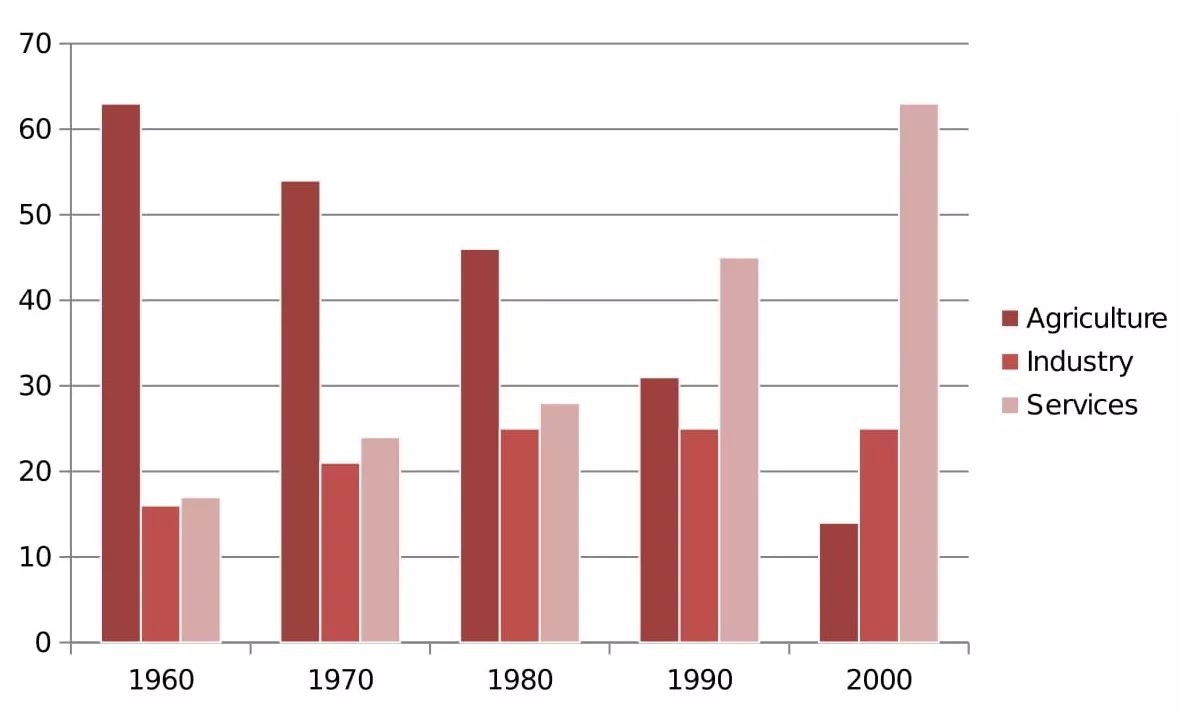
Source: EPW Research Foundation
Step 1 – Analyse the question
The format of every Academic Task 1 question is the same. Here is our practice question again with the words that will be included in all questions highlighted .
The bar chart below shows the sector contributions to India’s gross domestic product from 1960 to 2000.
Every question consists of:
- Sentence 1 – A brief description of the graphic
- Sentence 2 – The instructions
- The graphic – chart, graph, table, etc.
Sentence 2 tells you what you have to do.
You must do 3 things:
1. Select the main features.
2. Write about the main features.
3. Compare the main features.
All three tasks refer to the ‘ main features ’ of the graphic. You do not have to write about everything. Just pick out 2 or 3 key features and you’ll have plenty to write about.
Our practice graphic is a dynamic bar chart. That is, it includes a timeline giving data from several different points in time.
So, for this question, we need to identify the main trends (that is, the general developments or changes in situation) in the three key sectors of the Indian economy – agriculture, industry and service – between 1960 and 2000.
Alternatively, a bar chart may be static with the data coming from one point in time, as in the example below. For this graphic, we would need to compare the different variables, that is, the different leisure activities favoured by Canadian boys and girls.
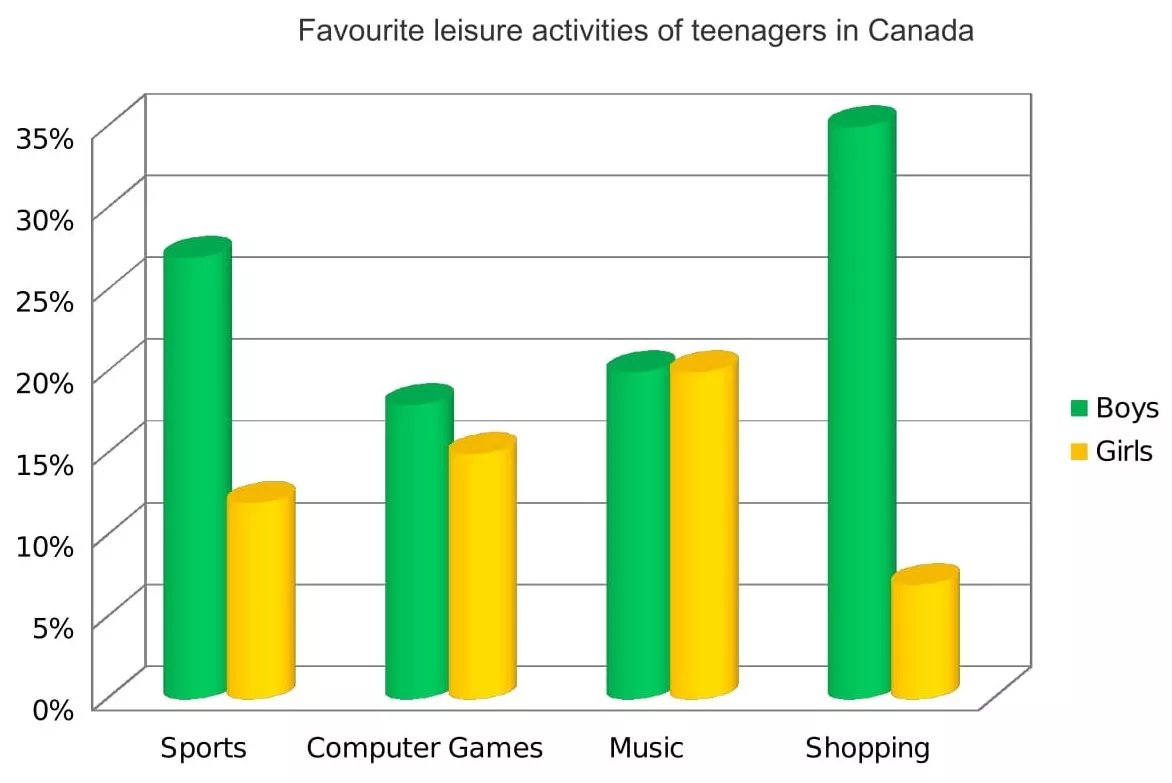
Step 2 – Identify the Main Features
The graphic in IELTS bar chart questions should not be difficult to interpret. Each question has been created to test your language skills, not your mathematics ability.
All you are looking for are the main features. These will usually be the easiest things to spot. As we’ve just seen, the type of key features will depend on whether the bar chart is dynamic or static.
There will be lots of information in the graphic to help you identify them. Here are some useful questions to ask?
- What information do the 2 axes give?
- Is it dynamic or static?
- What are the units of measurements?
- What are the time periods?
- What can you learn from the title and any labels?
- What is the most obvious trend?
- Are there any notable similarities?
(I give more detail on how to use these questions, plus downloadable checklists for identifying the main features of all 7 different types of IELTS Academic Writing Task 1 questions, in the lesson on How To Understand & Analyse Task 1 Questions .)
So, what main features stand out in our practice graphic?
Here's our practice IELTS bar chart again.

There are 3 main features/trends in this IELTS bar chart:
Main feature 1: The contribution of the agricultural sector dropped steadily.
Main feature 2: The contribution of the service sector increased each decade.
Main feature 3: Industry remained static from 1980 to 2000.
The general trends you select will be the starting point for your essay. You will then go on to add more detail.
With just 20 minutes allowed for Task 1, and a requirement of only 150 words, you won't be able to include many details.
We’re now ready to begin writing our essay. Here’s a reminder of the 4 part structure we’re going to use.
Step 3 – Write an Introduction
In the introduction, you should simply paraphrase the question, that is, say the same thing in a different way. You can do this by using synonyms and changing the sentence structure. For example:
Introduction (Paragraph 1):
The bar graph illustrates the relative percentage contributions made by the agricultural, industrial and service sectors to the Indian economy between 1960 and 2000.
This is all you need to do for the introduction.
Ideally, key words such as ‘sector’ and ‘contributions’ should be replaced by synonyms but there aren’t any obvious words that could be used instead so it’s fine to repeat them. It’s important that your language sounds natural so never try to force in synonyms that don’t quite fit.
Step 4 – Write an Overview (Paragraph 2)
In the second paragraph, you should report the main features you can see in the graph, giving only general information. The detail comes later in the essay. You should also make any clear comparisons you spot.
This is where we write about the general trends. Here are the ones we picked out above.
Now form these ideas into two or three sentences with a total of around 40 words. State the information simply using synonyms where possible. No elaborate vocabulary or grammar structures are required, just the appropriate words and correct verb tenses.
For example:
Overview (Paragraph 2) :
Over the whole time period, the significance of agriculture declined steadily while services grew in importance decade by decade. A different patterned emerged for industry, which initially showed a slowly increasing percentage but then plateaued from 1980 onwards.
Step 5 – Write the 1st Detail Paragraph
Paragraphs 3 and 4 of your IELTS bar chart essay are where you include more detailed information about the data in the graphic. In paragraph 3, you should give evidence to support your first 1 or 2 key features. Don’t forget to make comparisons when relevant.
Here are our first 2 main features again:
And this is an example of what you could write:
Paragraph 3 :
In 1960, agriculture contributed by far the highest percentage of GDP, peaking at 62%, but it then dropped in steady increments to a low of 12% in 2000. The service sector, on the other hand, had a relatively minor impact on the economy in 1960. This situation changed gradually at first, then its percentage contribution jumped from 28% to 43% between 1980 and 1990. By 2000 it matched the high point reached by agriculture in 1960, showing a reversal in the overall trend.
Step 6 – Write the 2nd Detail Paragraph
For the fourth and final paragraph, you do the same thing for your remaining feature/s. We have one main feature left to write about.
Here’s an example of what you could write:
Paragraph 4 :
Industry remained a steady contributor to India’s wealth throughout the period. As a sector, it grew marginally from 16% in 1960 to exactly a quarter in 1980 then remained static for the next two decades, maintaining a constant share of the overall GDP.
Here are the four paragraphs brought together to create our finished essay.

Finished IELTS Bar Chart Essay
(188 words)
This sample IELTS bar chart essay is well over the minimum word limit so you can see that you don’t have space to include very much detail at all. That’s why it is essential to select just a couple of main features to write about.
Now use what you’ve learnt in this lesson to practice answering other IELTS bar chart questions. Start slowly at first and keep practicing until you can plan and write a complete essay in around 20 minutes.
Want to watch and listen to this lesson?
Click on this video.
Would you prefer to share this page with others by linking to it?
- Click on the HTML link code below.
- Copy and paste it, adding a note of your own, into your blog, a Web page, forums, a blog comment, your Facebook account, or anywhere that someone would find this page valuable.
Like this page?
Ielts academic writing task 1 – all lessons.
IELTS Academic Writing – A summary of the test including important facts, test format & assessment.
Academic Writing Task 1 – The format, the 7 question types & sample questions, assessment & marking criteria. All the key information you need to know.
Understanding Task 1 Questions – How to quickly and easily analyse and understand IELTS Writing Task 2 questions.
How To Plan a Task 1 Essay – Discover 3 reasons why you must plan, the 4 simple steps of essay planning and learn a simple 4 part essay structure.
Vocabulary for Task 1 Essays – Learn key vocabulary for a high-scoring essay. Word lists & a downloadable PDF.
Grammar for Task 1 Essays – Essential grammar for Task 1 Academic essays including, verb tenses, key sentence structures, articles & prepositions.
The 7 Question Types:
Click the links below for a step-by-step lesson on each type of Task 1 question.
- Table Chart
- Process Diagram
- Multiple Graphs
- IELTS Writing
- IELTS Bar Chart
- Back To Top
* New * Grammar For IELTS Ebooks

$9.99 each Full Set Just $ 23.97
Find Out More >>
IELTS Courses

Full details...

IELTS Writing Ebook

Discount Offer
$7 each Full Set Just $ 21

Find out more >>
Testimonials
“I am very excited to have found such fabulous and detailed content. I commend your good work.” Jose M.
“Thanks for the amazing videos. These are ‘to the point’, short videos, beautifully explained with practical examples." Adari J.
"Hi Jacky, I bought a listening book from you this morning. You know what? I’m 100% satisfied. It’s super helpful. If I’d had the chance to read this book 7 years ago, my job would be very different now." Loi H.
"Hi Jacky, I recently got my IELTS results and I was pleased to discover that I got an 8.5 score. I'm firmly convinced your website and your videos played a strategic role in my preparation. I was able to improve my writing skills thanks to the effective method you provide. I also only relied on your tips regarding the reading section and I was able to get a 9! Thank you very much." Giano
“After listening to your videos, I knew I had to ditch every other IELTS tutor I'd been listening to. Your explanations are clear and easy to understand. Anyways, I took the test a few weeks ago and my result came back: Speaking 7, listening 9, Reading 8.5 and Writing 7 with an average band score of 8. Thanks, IELTS Jacky." Laide Z.
Contact
About Me
Site Map
Privacy Policy
Disclaimer
IELTS changes lives.
Let's work together so it changes yours too.
Copyright © 2024 IELT Jacky
All Right Reserved
IELTS is a registered trademark of the University of Cambridge, the British Council, and IDP Education Australia. This site and its owners are not affiliated, approved or endorsed by the University of Cambridge ESOL, the British Council, and IDP Education Australia.
IELTS Preparation with Liz: Free IELTS Tips and Lessons, 2024
- Test Information FAQ
- Band Scores
- IELTS Candidate Success Tips
- Computer IELTS: Pros & Cons
- How to Prepare
- Useful Links & Resources
- Recommended Books
- Writing Task 1
- Writing Task 2
- Speaking Part 1 Topics
- Speaking Part 2 Topics
- Speaking Part 3 Topics
- 100 Essay Questions
- On The Day Tips
- Top Results
- Advanced IELTS
IELTS Sample Charts for Writing Task 1 Practice
Below are sample IELTS charts to practise writing task 1 at home. In the IELTS writing task 1 (academic paper), you will be given one of the following and will have 20 mins to write a full report:
- diagram or process
- combination of the above (multiple tasks)
This collection of IELTS charts represents the main types of charts that you can be given in writing task 1, including tasks with two or three charts combined. Please remember that writing task 1 is not an essay, it is a report.
Use the sample practice charts, tables and diagrams below to practise and develop your IELTS writing task 1. Some charts below have links to model answers. Charts not created by myself have the known source stated when possible.
Practice Charts for IELTS Writing Task 1
You must write a report of over 150 words You have 20 mins for this task
IELTS Bar Chart Practice Samples
The bar chart below shows the percentage of people who ate five portions of fruit and vegetables per day in the UK from 2001 to 2008.
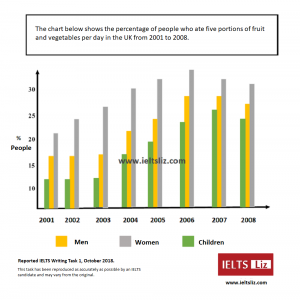
- Source: IELTS Liz, Reported by IELTS Candidate
- Download: IELTS Writing task 1 October 2018
- Model Answer: Answer
The bar chart below shows the hours per week that teenagers spend doing certain activities in Chester from 2002 to 2007.
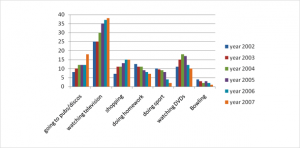
- Source: English-in-Chester
The chart below shows the global sales of different kinds of digital games from 2000 to 2006.
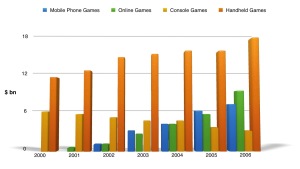
- Source: Chart not by IELTS Liz. Source unknown.
IELTS Line Graph Practice Samples
The graph below shows the population figures for different type of turtles in India from 1980 to 2012.

- Source: Graph not designed by IELTS Liz. Source unknown.
The graph below shows the amount of goods transported in the UK from 1974 to 2002.

- Source: IELTS Cambridge English Test Books
- Useful Tips: Tips
The line graph below shows the consumption of 4 kinds of meat in a European country from 1979 to 2004.

IELTS Table Practice Samples
The table below shows the proportion of income spent on 4 common items in the UK in 1998.

- Source: Table not designed by IELTS Liz. Source unknown

- Source: IELTS Liz, Reported by IELTS candidate
The table below gives information about the underground railway systems in 6 countries.

The table below shows consumer spending on different items in 5 countries in 2002.

The table below gives information about the employment sectors in which people from 3 age groups worked.

IELTS Pie Chart Practice Samples
The pie charts below show the average household expenditures in a county in 1950 and 2010.
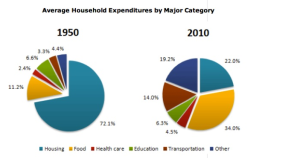
- Source: Charts not designed by IELTS Liz. Source unknown.
The charts below show the percentage of students joining North West University.

The charts below give information about the electricity generation in two countries in 2009.

The pie charts below show the spending of a school in the UK from 1981 to 2001.
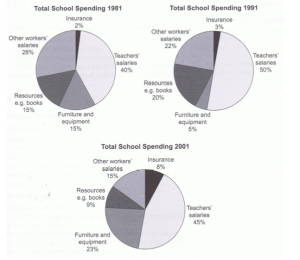
IELTS Diagram Practice Samples
The diagram below shows how rainwater is collected for the use of drinking water in an Australian town.
The diagram below shows the water supply in Australia at present and in the future.
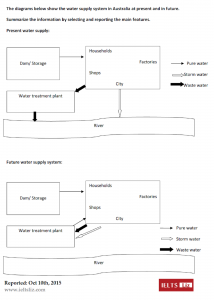
The diagram below shows how the water cycle works.

- Source: New Insight into IELTS
- Although this book was published years ago, I still recommend it for practise at home.
The diagram shows the process of making coffee.
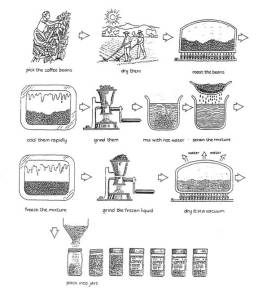
- Source: Diagram not designed by IELTS Liz. Source unknown.
The diagram below shows how coal is used to generate electricity.
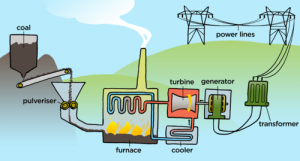
- Source: mstworkbooks.co.za , natural sciences.
IELTS Map Practice Sample

IELTS Multiple Charts Practice Samples
Two Bar Charts
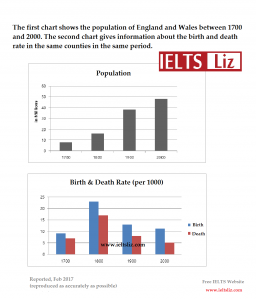
- Download PDF: IELTS 2017 Writing Task 1
Bar Chart & Two Pie Charts The charts below give information about levels of education in Glasgow, a city in Scotland, in 2010.
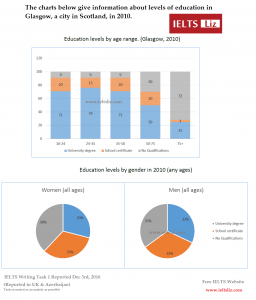
Table & 3 Pie Charts

Two Pie Charts & Bar Chart
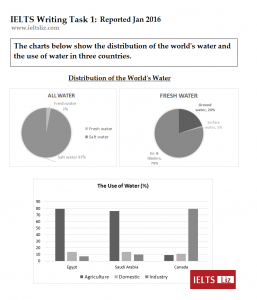
Useful Links for Free IELTS Preparatio
IELTS Writing Task 1: Tips, Answers, Vocabulary & Videos
IELTS Writing Task 2: Model Essays, Linking Words & Videos
All the best
Advanced IELTS Lessons & E-books

Click Below to Learn:
- IELTS Test Information
Copyright Notice
Copyright © Elizabeth Ferguson, 2014 – 2024
All rights reserved.
Privacy Policy & Disclaimer
- Click here: Privacy Policy
- Click here: Disclaimer
Return to top of page
Copyright © 2024 · Prose on Genesis Framework · WordPress · Log in
SWOT Analysis: How To Do One [With Template & Examples]
Published: October 05, 2023
As your business grows, you need a roadmap to help navigate the obstacles, challenges, opportunities, and projects that come your way. Enter: the SWOT analysis.

This framework can help you develop a plan to determine your priorities, maximize opportunities, and minimize roadblocks as you scale your organization. Below, let’s go over exactly what a SWOT analysis is, a few SWOT analysis examples, and how to conduct one for your business.
![essay analysis chart example → Download Now: Market Research Templates [Free Kit]](https://no-cache.hubspot.com/cta/default/53/6ba52ce7-bb69-4b63-965b-4ea21ba905da.png)
When you’re done reading, you’ll have all the inspiration and tactical advice you need to tackle a SWOT analysis for your business.
What is a SWOT analysis? Importance of a SWOT Analysis How to Write a Good SWOT Analysis SWOT Analysis Examples How to Act on a SWOT Analysis
What is a SWOT analysis?
A SWOT analysis is a strategic planning technique that puts your business in perspective using the following lenses: Strengths, Weaknesses, Opportunities, and Threats. Using a SWOT analysis helps you identify ways your business can improve and maximize opportunities, while simultaneously determining negative factors that might hinder your chances of success.
While it may seem simple on the surface, a SWOT analysis allows you to make unbiased evaluations on:
- Your business or brand.
- Market positioning.
- A new project or initiative.
- A specific campaign or channel.
Practically anything that requires strategic planning, internal or external, can have the SWOT framework applied to it, helping you avoid unnecessary errors down the road from lack of insight.
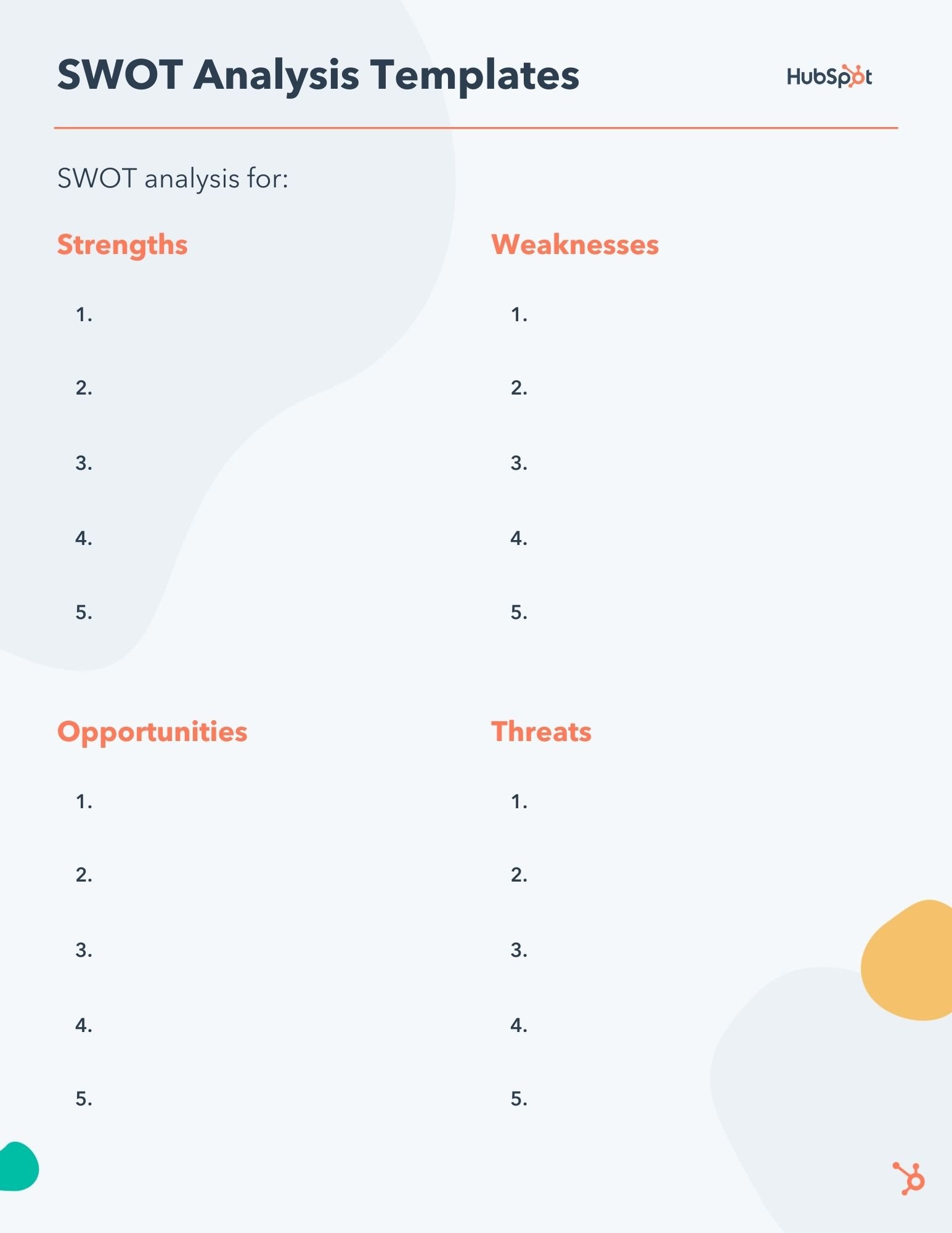
Free SWOT Analysis Template
A free SWOT analysis template, plus other helpful market research resources.
Opportunities
You're all set.
Click this link to access this resource at any time.
Importance of a SWOT Analysis
You’ve noticed by now that SWOT stands for Strengths, Weaknesses, Opportunities, and Threats. The framework seems simple enough that you’d be tempted to forgo using it at all, relying instead on your intuition to take these things into account.
But you shouldn’t. Doing a SWOT analysis is important. Here’s why.
SWOT gives you the chance to worry and to dream.
A SWOT analysis is an important step in your strategic process because it gives you the opportunity to explore both the potential risks and the exciting possibilities that lie ahead. You’re giving yourself the space to dream, evaluate, and worry before taking action. Your insights then turn into assets as you create the roadmap for your initiative.
For instance, when you consider the weaknesses and threats that your business may face, you can address any concerns or challenges and strategize on how to mitigate those risks. At the same time, you can identify strengths and opportunities, which can inspire innovative ideas and help you dream big. Both are equally important.
SWOT forces you to define your variables.
Instead of diving head first into planning and execution, you’re taking inventory of all your assets and roadblocks. This process will help you develop strategies that leverage your strengths and opportunities while addressing and mitigating the impact of weaknesses and threats.
As a result, you'll gain a comprehensive understanding of your current situation and create a more specific and effective roadmap. Plus, a SWOT analysis is inherently proactive. That means you'll be better equipped to make informed decisions, allocate resources effectively, and set realistic goals.
SWOT allows you to account for mitigating factors.
As you identify weaknesses and threats, you’re better able to account for them in your roadmap, improving your chances of success.
Moreover, accounting for mitigating factors allows you to allocate your resources wisely and make informed decisions that lead to sustainable growth. With a SWOT analysis as a guide, you can confidently face challenges and seize opportunities.
SWOT helps you keep a written record.
As your organization grows and changes, you’ll be able to strike things off your old SWOTs and make additions. You can look back at where you came from and look ahead at what’s to come.
In other words, SWOT analyses serve as a tangible history of your progress and provide a reference point for future decision-making. With each update, your SWOT analysis becomes a living document that guides your strategic thinking and helps you stay agile and adaptable in an ever-changing business landscape.
By maintaining this written record, you foster a culture of continuous improvement and empower your team to make data-driven decisions and stay aligned with your long-term vision.
Parts of a SWOT Analysis
Conducting a SWOT analysis will help you strategize effectively, unlock valuable insights, and make informed decisions. But what exactly does a SWOT analysis include?
Let’s explore each component: Strengths, Weaknesses, Opportunities, and Threats.
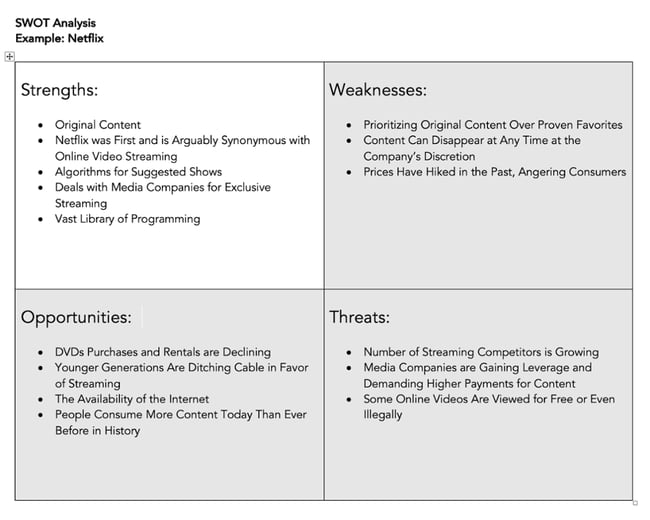
Your strengths are the unique advantages and internal capabilities that give your company a competitive edge in the market. A strong brand reputation, innovative products or services, or exceptional customer service are just a few examples. By identifying and capitalizing on your strengths, you can foster customer loyalty and build a solid foundation for growth.
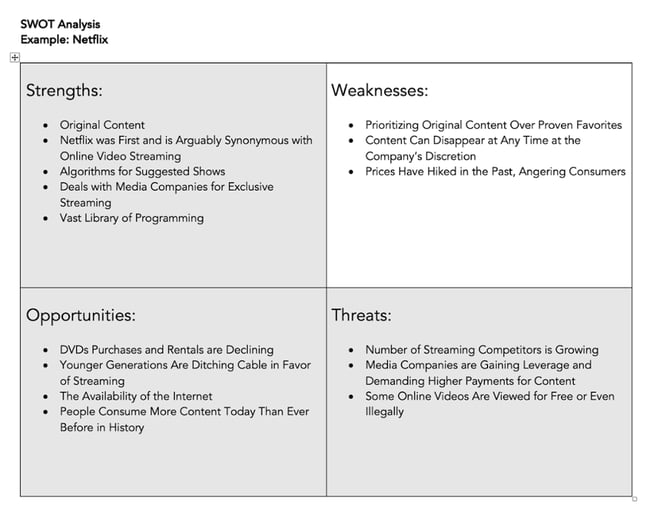
No business is flawless. Weaknesses are areas where you may face challenges or fall short of your potential. It could be outdated processes, skill gaps within the team, or inadequate resources. By acknowledging these weaknesses, you can establish targeted initiatives for improvement, upskill your team, adopt new technologies, and enhance your overall operational efficiency.
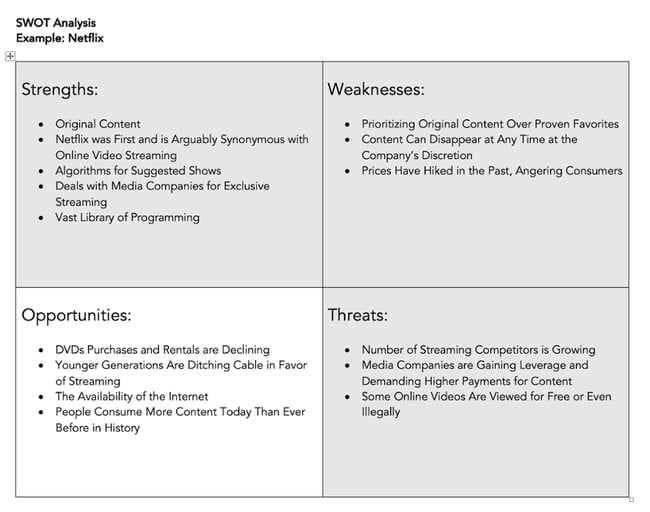
Opportunities are external factors that can contribute to your company's progress. These may include emerging markets, technological advancements, changes in consumer behavior, or gaps in the market that your company can fill. By seizing these opportunities, you can expand your market reach, diversify your product offerings, forge strategic partnerships, or even venture into untapped territories.
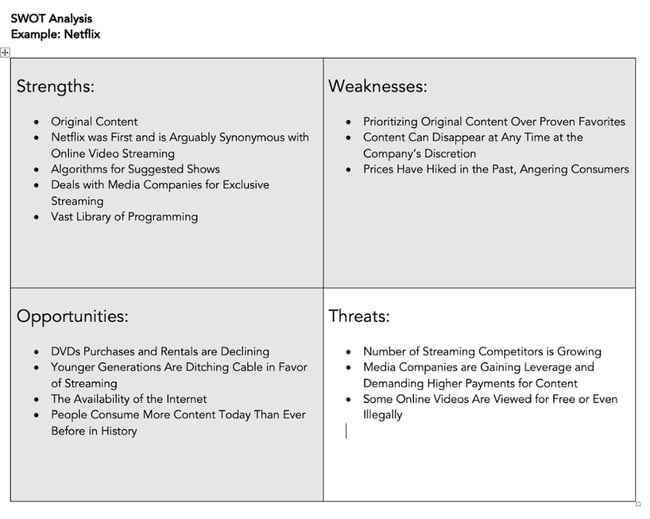
Threats are external factors that are beyond your control and pose challenges to your business. Increased competition, economic volatility, evolving regulatory landscapes, or even changing market trends are examples of threats. By proactively assessing and addressing them, you can develop contingency plans, adjust your strategies, and minimize their impact on your operations.
In a SWOT analysis, you’ll have to take both internal and external factors into account. We’ll cover those next.
.png)
Free Market Research Kit
5 Research and Planning Templates + a Free Guide on How to Use Them in Your Market Research
- SWOT Analysis Template
- Survey Template
- Focus Group Template
SWOT Analysis Internal and External Factors
A SWOT analysis typically has internal (i.e., within your organization) and external (i.e., outside your organization) factors at play. Here's a breakdown of each.
Internal Factors
Internal factors refer to the characteristics and resources within your organization that directly influence its operations and performance. These factors are completely within your organization's control, so they can be modified, improved, or capitalized upon.
In a SWOT analysis, strengths and weaknesses are categorized as internal factors. Let’s look at a few examples.
- Brand reputation
- Unique expertise
- Loyal customer base
- Talented workforce
- Efficient processes
- Proprietary technology
- Outdated technology
- Inadequate resources
- Poor financial health
- Inefficient processes
- Skill gaps within the team
External Factors
External factors are elements outside the organization's control that have an impact on its operations, market position, and success. These factors arise from the industry climate and the broader business environment. You typically have no control over external factors, but you can respond to them.
In a SWOT analysis, opportunities and threats are categorized as external factors. Let’s look at a few examples.
- Emerging markets
- Changing consumer trends
- Technological advancements
- Positive shifts in regulations
- New gaps in the market you could fill
- Intense competition
- Economic downturns
- Disruptive technologies
- Changing regulations
- Negative shifts in consumer behavior
Remember, a well-rounded SWOT analysis empowers you to capitalize on strengths, address weaknesses, seize opportunities, and navigate threats — all while making informed decisions for the future.
Now, let’s take a look at how you can write a good SWOT analysis for yourself or for stakeholders.
How do you write a good SWOT analysis?
There are several steps you’ll want to take when evaluating your business and conducting a strategic SWOT analysis.
1. Download HubSpot's SWOT Analysis Template.
There’s no need to start from scratch for your analysis. Instead, start by downloading a free, editable template from HubSpot. Feel free to use the model yourself, or create your own as it suits your needs.
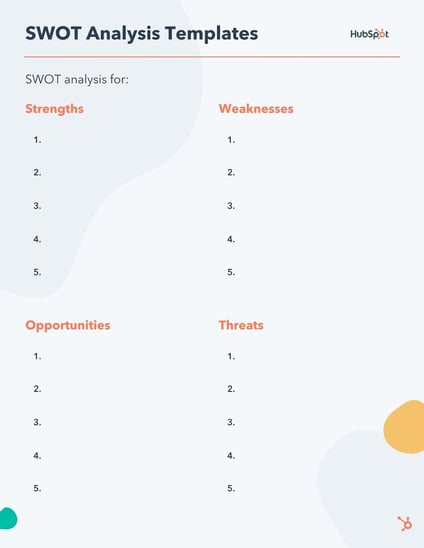
3. Identify your objective.
Before you start writing things down, you’ll need to figure out what you’re evaluating with your SWOT analysis.
Be specific about what you want to analyze. Otherwise, your SWOT analysis may end up being too broad, and you’ll get analysis paralysis as you are making your evaluations.
If you’re creating a new social media program, you’ll want to conduct an analysis to inform your content creation strategy. If you’re launching a new product, you’ll want to understand its potential positioning in the space. If you’re considering a brand redesign, you’ll want to consider existing and future brand conceptions.
All of these are examples of good reasons to conduct a SWOT analysis. By identifying your objective, you’ll be able to tailor your evaluation to get more actionable insights.
4. Identify your strengths.
“Strengths” refers to what you are currently doing well. Think about the factors that are going in your favor as well as the things you offer that your competitors just can’t beat.
For example, let’s say you want to use a SWOT analysis to evaluate your new social media strategy.
If you’re looking at a new social media program, perhaps you want to evaluate how your brand is perceived by the public. Is it easily recognizable and well-known? Even if it’s not popular with a widespread group, is it well-received by a specific audience?
Next, think about your process: Is it effective or innovative? Is there good communication between marketing and sales?
Finally, evaluate your social media message, and in particular, how it differs from the rest of the industry. I’m willing to bet you can make a lengthy list of some major strengths of your social media strategy over your competitors, so try to dive into your strengths from there.
5. Identify your weaknesses.
In contrast to your strengths, what are the roadblocks hindering you from reaching your goals? What do your competitors offer that continues to be a thorn in your side?
This section isn’t about dwelling on negative aspects. Rather, it’s critical to foresee any potential obstacles that could mitigate your success.
When identifying weaknesses, consider what areas of your business are the least profitable, where you lack certain resources, or what costs you the most time and money. Take input from employees in different departments, as they’ll likely see weaknesses you hadn’t considered.
If you’re examining a new social media strategy, you might start by asking yourself these questions: First, if I were a consumer, what would prevent me from buying this product, or engaging with this business? What would make me click away from the screen?
Second, what do I foresee as the biggest hindrance to my employees’ productivity, or their ability to get the job done efficiently? What derails their social media efforts?
6. Consider your opportunities.
This is your chance to dream big. What are some opportunities for your social media strategy you hope, but don’t necessarily expect, to reach?
For instance, maybe you’re hoping your Facebook ads will attract a new, larger demographic. Maybe you’re hoping your YouTube video gets 10,000 views and increases sales by 10%.
Whatever the case, it’s important to include potential opportunities in your SWOT analysis. Ask yourself these questions:
- What technologies do I want my business to use to make it more effective?
- What new target audience do I want to reach?
- How can the business stand out more in the current industry?
- Is there something our customers complain about that we could fix?
The opportunities category goes hand-in-hand with the weaknesses category. Once you’ve made a list of weaknesses, it should be easy to create a list of potential opportunities that could arise if you eliminate your weaknesses.
7. Contemplate your threats.
It’s likely, especially if you’re prone to worry, you already have a good list of threats in your head.
If not, gather your employees and brainstorm. Start with these questions:
- What obstacles might prevent us from reaching our goals?
- What’s going on in the industry, or with our competitors, that might mitigate our success?
- Is there new technology out there that could conflict with our product?
Writing down your threats helps you evaluate them objectively.
For instance, maybe you list your threats in terms of least and most likely to occur and divide and conquer each. If one of your biggest threats is your competitor’s popular Instagram account, you could work with your marketing department to create content that showcases your product’s unique features.
SWOT Analysis Chart
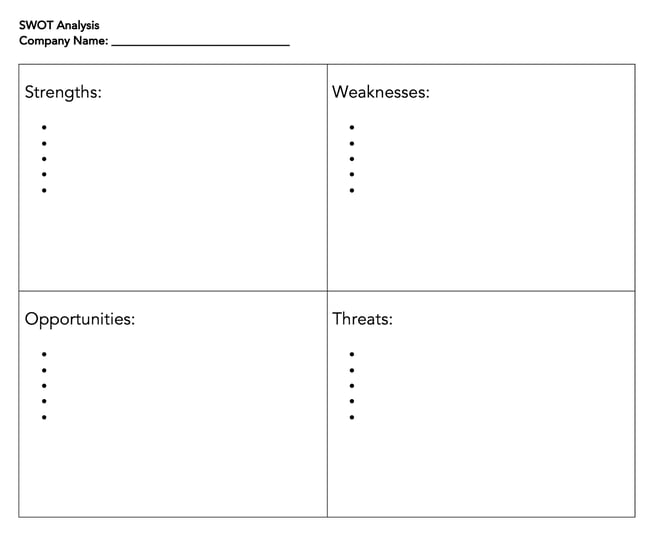
Download a free SWOT analysis chart included in HubSpot’s free market research kit .
A SWOT analysis doesn’t have to be fancy. Our SWOT analysis chart provides a clear and structured framework for capturing and organizing your internal strengths and weaknesses, and external opportunities and threats. It's the perfect visual aid to make sense of the wealth of information gathered during your analysis.
(Plus, you can always customize and paste it into a document you plan to share with stakeholders.)
But remember: Filling out the SWOT chart is just one step in the process. Combine it with our entire market research kit , and you'll have all the tools necessary to help your organization navigate new opportunities and threats.
SWOT Analysis Examples
The template above helps get you started on your own SWOT analysis.
But, if you’re anything like me, it’s not enough to see a template. To fully understand a concept, you need to see how it plays out in the real world.
These SWOT examples are not exhaustive. However, they are a great starting point to inspire you as you do your own SWOT analysis.
Apple’s SWOT analysis
Here’s how we’d conduct a SWOT analysis on Apple.

First off, strengths. While Apple has many strengths, let’s identify the top three:
- Brand recognition.
- Innovative products.
- Ease of use.
Apple’s brand is undeniably strong, and its business is considered the most valuable in the world . Since it’s easily recognized, Apple can produce new products and almost ensure a certain degree of success by virtue of the brand name itself.
Apple’s highly innovative products are often at the forefront of the industry. One thing that sets Apple apart from the competition is its product inter-connectivity.
For instance, an Apple user can easily sync their iPhone and iPad together. They can access all of their photos, contacts, apps, and more no matter which device they are using.
Lastly, customers enjoy how easy it is to use Apple’s products. With a sleek and simple design, each product is developed so that most people can quickly learn how to use them.
Next, let’s look at three of Apple’s weaknesses.
- High prices
- Closed ecosystem
- Lack of experimentation
While the high prices don’t deter Apple’s middle- and upper-class customer base, they do hinder Apple’s ability to reach a lower-class demographic.
Apple also suffers from its own exclusivity. Apple controls all its services and products in-house, and while many customers become loyal brand advocates for this reason, it means all burdens fall on Apple employees.
Ultimately, Apple’s tight control over who distributes its products limits its market reach.
Lastly, Apple is held to a high standard when it comes to creating and distributing products. Apple’s brand carries a high level of prestige. That level of recognition inhibits Apple from taking risks and experimenting freely with new products that could fail.
Now, let’s take a look at opportunities for Apple.
It’s easy to recognize opportunities for improvement, once you consider Apple’s weaknesses. Here’s a list of three we came up with:
- Expand distribution options.
- Create new product lines.
- Technological advancement.
One of Apple’s biggest weaknesses is its distribution network, which, in the name of exclusivity, remains relatively small. If Apple expanded its network and enabled third-party businesses to sell its products, it could reach more people globally, while alleviating some of the stress currently put on in-house employees.
There are also plenty of opportunities for Apple to create new products. Apple could consider creating more affordable products to reach a larger demographic, or spreading out into new industries — Apple self-driving cars, perhaps?
Finally, Apple could continue advancing its products’ technology. Apple can take existing products and refine them, ensuring each product offers as many unique features as possible.
Finally, let’s look at threats to Apple.
Believe it or not, they do exist.
Here are three of Apple’s biggest threats:
- Tough competition.
- International issues.
Apple isn’t the only innovative tech company out there, and it continues to face tough competition from Samsung, Google, and other major forces. In fact, Samsung sold more smartphones than Apple did in Q1 of 2022 , shipping 17 million more units than Apple and holding 24% of the market share.
Many of Apple’s weaknesses hinder Apple’s ability to compete with the tech corporations that have more freedom to experiment, or that don’t operate in a closed ecosystem.
A second threat to Apple is lawsuits. Apple has faced plenty of lawsuits, particularly between Apple and Samsung . These lawsuits interfere with Apple’s reputable image and could steer some customers to purchase elsewhere.
Finally, Apple needs to improve its reach internationally. The company isn’t number one in China and doesn’t have a very positive relationship with the Chinese government. In India, which has one of the largest consumer markets in the world, Apple’s market share is low , and the company has trouble bringing stores to India’s market.
If Apple can’t compete globally the way Samsung or Google can, it risks falling behind in the industry.
Starbucks SWOT Analysis
Now that we’ve explored the nuances involved with a SWOT analysis, let’s fill out a SWOT template using Starbucks as an example.
Here’s how we’d fill out a SWOT template if we were Starbucks:

Download this Template for Free
Restaurant Small Business SWOT Analysis
Some small business marketers may have difficulty relating to the SWOTs of big brands like Apple and Starbucks. Here’s an example of how a dine-in Thai restaurant might visualize each element.
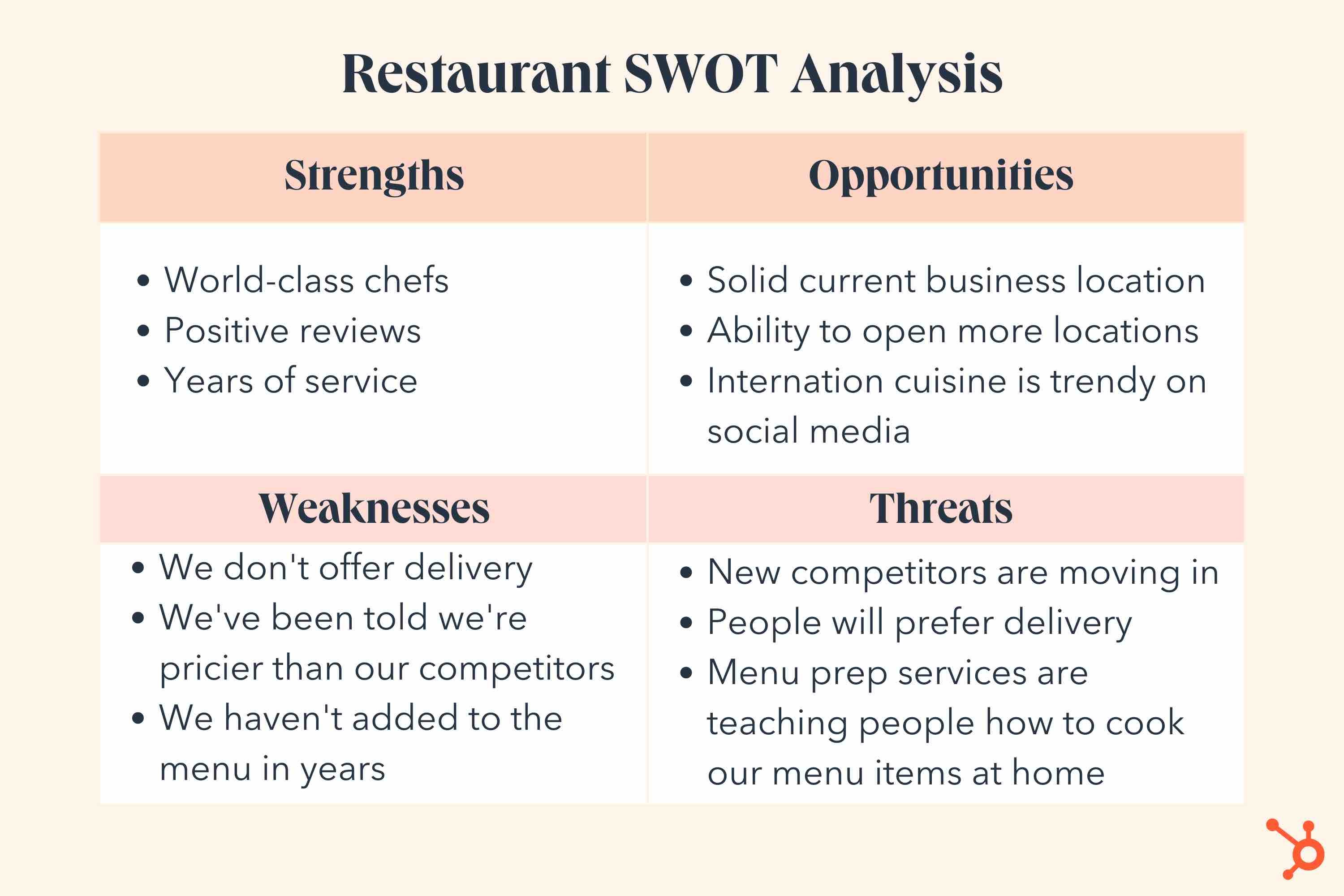
Small restaurants can lean into their culinary expertise and service skills to find opportunities for growth and brand awareness. A SWOT analysis can also help identify weaknesses that can be improved, such as menu variation and pricing.
While a restaurant might not be as worried about high-level lawsuits, a small business might be more concerned about competitors or disruptors that might enter the playing field.
Local Boutique SWOT Analysis
In another small business example, let’s take a look at a SWOT analysis for a local boutique.
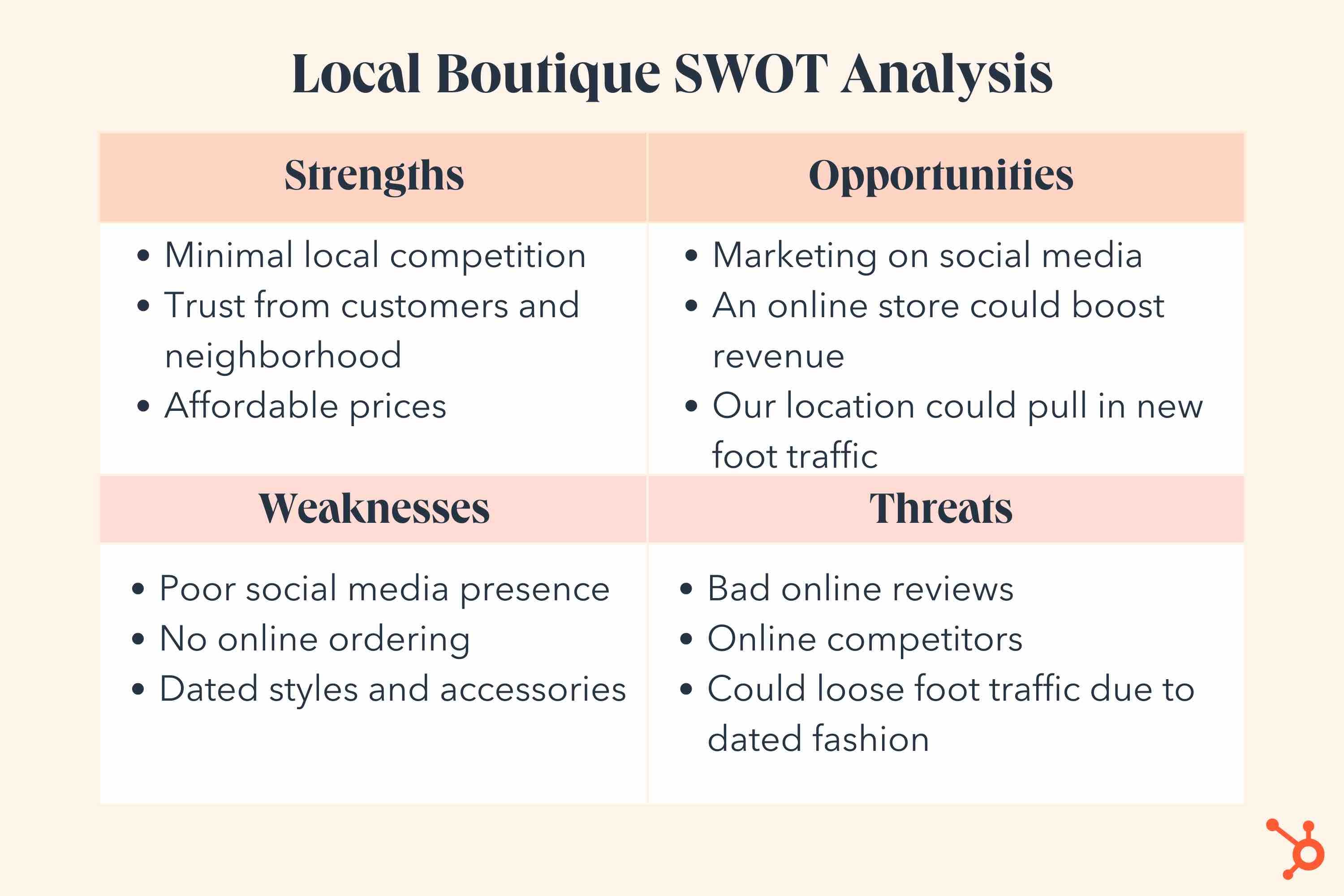
This shop might be well known in its neighborhood, but it also might take time to build an online presence or get its products in an online store.
Because of this, some of its strengths and opportunities might relate to physical factors while weaknesses and threats might relate to online situations.
How to Act on a SWOT Analysis
After conducting a SWOT analysis, you may be asking yourself: What’s next?
Putting together a SWOT analysis is only one step. Executing the findings identified by the analysis is just as important — if not more.
Put your insights into action using the following steps.
Take advantage of your strengths.
Use your strengths to pursue opportunities from your analysis.
For example, if we look at the local boutique example above, the strength of having affordable prices can be a value proposition. You can emphasize your affordable prices on social media or launch an online store.
Address your weaknesses.
Back to the boutique example, one of its weaknesses is having a poor social media presence. To mitigate this, the boutique could hire a social media consultant to improve its strategy. They may even tap into the expertise of a social-savvy employee.
Make note of the threats.
Threats are often external factors that can’t be controlled, so it’s best to monitor the threats outlined in your SWOT analysis to be aware of their impacts on your business.
When to Use a SWOT Analysis
While the examples above focus on business strategy in general, you can also use a SWOT analysis to evaluate and predict how a singular product will play out in the market.
Ultimately, a SWOT analysis can measure and tackle both big and small challenges, from deciding whether or not to launch a new product to refining your social media strategy.
Editor's note: This post was originally published in May 2018 and has been updated for comprehensiveness.

Don't forget to share this post!
Related articles.

25 Tools & Resources for Conducting Market Research

What is a Competitive Analysis — and How Do You Conduct One?

Market Research: A How-To Guide and Template

TAM SAM SOM: What Do They Mean & How Do You Calculate Them?
![essay analysis chart example How to Run a Competitor Analysis [Free Guide]](https://blog.hubspot.com/hubfs/Google%20Drive%20Integration/how%20to%20do%20a%20competitor%20analysis_122022.jpeg)
How to Run a Competitor Analysis [Free Guide]
![essay analysis chart example 5 Challenges Marketers Face in Understanding Audiences [New Data + Market Researcher Tips]](https://blog.hubspot.com/hubfs/challenges%20marketers%20face%20in%20understanding%20the%20customer%20.png)
5 Challenges Marketers Face in Understanding Audiences [New Data + Market Researcher Tips]

Causal Research: The Complete Guide

Total Addressable Market (TAM): What It Is & How You Can Calculate It

What Is Market Share & How Do You Calculate It?
![essay analysis chart example 3 Ways Data Privacy Changes Benefit Marketers [New Data]](https://blog.hubspot.com/hubfs/how-data-privacy-benefits-marketers_1.webp)
3 Ways Data Privacy Changes Benefit Marketers [New Data]
Download a free SWOT analysis template in our free market research kit.
Marketing software that helps you drive revenue, save time and resources, and measure and optimize your investments — all on one easy-to-use platform
- Skip to primary navigation
- Skip to main content
- Skip to primary sidebar
- Skip to footer

IELTS Advantage
IELTS Preparation Courses
IELTS Bar Chart Sample Essay
Static or Dynamic?
Before writing an IELTS task 1 bar chart or line graph answer it is important that we analyse the question correctly. Taking a few minutes to do this will help us write a clear answer that fully responds to the question. Just what the examiner wants us to do.
The first thing we need to do is decide if the bar chart is static or dynamic. Static means that the data comes from one point in time. Dynamic means the data comes from more than one point in time.
Whether a chart is static or dynamic will affect the information we choose to include in our answer and the kind of language (tense, grammar etc.) we use.
If it is dynamic we will have to compare the different times and comment on the general trends over the time period.
If it is static we will have to compare the different variables, in this case countries, car price, GDP and time it takes for one person to buy a car.
Main Features
Every IELTS academic task 1 question asks us to ‘select and report the main features’.
This means that we have to not only pick the most significant information from the graph and include it in our essay, but also decide which information is not important and should therefore not be included in our essay. One of the biggest mistakes you can make in task 1 is including all the information you see.
So which information should you choose?
You should look for:
- highest/lowest values
- biggest differences
- similarities
- significant exceptions
- anything else that really stands out
There are 3 main features in this graph
1) It takes over 26 years for a Vietnamese person to buy a car.
2) Vietnam has the second highest average costs but the second lowest wages.
3) Cost of a car in Singapore is nearly 3 times the next most expensive.
I advise my students to follow a basic four paragraph structure for these kinds of questions.
Paragraph 1
Paraphrase the question using synonyms.
Paragraph 2
Provide an overview of the main features. No need to include any data in this paragraph, just tell the examiner what is happening in general terms. If you had to describe the main features in two sentences, what would you say?
Paragraph 3
This is where we get more specific and use data. Take 2 of the main features (from your overview) and describe them in detail using data from the chart.
Paragraph 4
Simply do the same thing as you did in paragraph 3, but with two other main features (from your overview).
Sample Answer
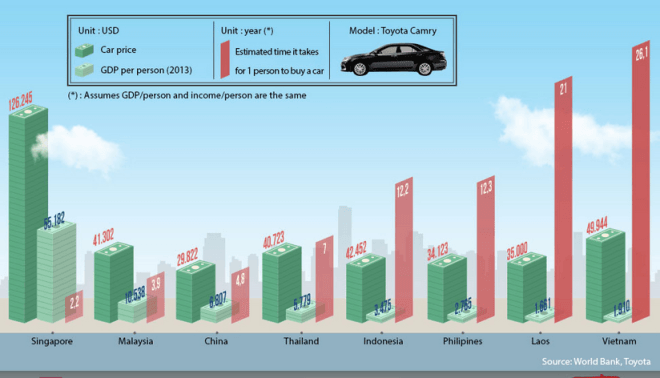
The graph compares the GDP per capita, cost of a Toyota Camry and approximate length of time it takes for 1 citizen to purchase that mode of transport in eight Asian countries.
Despite having the second lowest average yearly income, it costs more to buy this car in Vietnam than in all but one other Asian nation. It also takes significantly longer for a standard person to buy an automobile in Vietnam than in any other state in Asia. On the other end of the scale, Singaporeans have to pay nearly three times more for their cars than the Vietnamese and it takes them the least amount of time to afford a motor vehicle.
It costs $49,944 to buy a Toyota Camry in Vietnam, but this dwarfs the average yearly income per person at just $1,910. It would therefore take a normal man or woman 26.1 years to save up for that particular car.
This is in contrast to Singapore where it costs $126,245 for that model of motorcar, however the average salary is much greater at $55,182. This means that it generally takes just over 2 years for a typical individual from Singapore to acquire this vehicle.
(200 words) Band 9.
It should be noted that this is not a real IELTS task 1 question. This is just a chart that I saw on the internet, but it allowed me to make a very important point- you don’t have to mention everything on the graph. I only talked about 2 out of the 8 countries and I still wrote 200 words and answer the question fully. The key is finding the most significant data and not talking about anything else. Don’t worry, you won’t lose marks for not talking about everything, quite the opposite.
This graph is also good for demonstrating how important it is to vary your vocabulary. There were four words that could have been overused in this essay- car, average, country and people. Instead of repeating them over and over again I used synonyms to show the examiner I have a wide vocabulary and gain extra marks. Here are the synonyms:
Car- Toyota Camry- automobile- vehicle- motor vehicle- motorcar
Average- approximate- normal- typical- standard
Country- countries- nation- state
People- citizen- man or woman- individual
Next time you see a chart or graph in a newspaper, in a textbook or on the internet, think about what the main features are and what common words would you have to vary with synonyms.
I hope you have found these tips useful. If you have any questions, let me know below.
For more band 9 sample essays check out our task 1 sample essay page.
About Christopher Pell
My name is Christopher Pell and I'm the Managing Director of IELTS Advantage.
I started IELTS Advantage as a simple blog to help 16 students in my class. Several years later, I am very humbled that my VIP Course has been able to help thousands of people around the world to score a Band 7+ in their IELTS tests.
If you need my help with your IELTS preparation, you can send me an email using the contact us page.
IELTS Writing Task 1 – Bar Chart Essay Example 1
In this post, we will look at a Writing Task 1 Academic bar chart essay example from the IELTS writing task 1 Academic Test. Students often ask if the questions are repeated year after year and the answer is no, but the type of chart or graph can be.
There are so many questions written each year, you may find you practice answering various questions on different topics. It is best practice to learn how to answer each one of the various types of writing task 1 questions , from bar charts, line graphs, maps, process etc.
If you would like to learn how to structure a charts and graphs essay please click the button below >
Take a look at the IELTS Writing Task 1 Academic essay example below >>
*This chart question and answer were provided by a student. IELTS Achieve did not design this bar chart question*
The bar chart describes comparative statistics on the number of products exported by Someland in 2005 and 2015 and its projected exports for 2025. The units were measured in USD billion.
Overall, the most profitable export Someland had from 2005 and 2015 was from international tourism, while the lowest can be seen in meat produce. It can also be seen in the data that by 2025 they are still expecting that international travels will dominate the Someland export industry whereas meat produce will still bring in the least amount of revenue.
On the one hand, the graph shows that International tourism was consistently high, with nearly 6.5 billion USD earned in 2005 and almost 7 billion USD in 2015. Similarly, this can be said in dairy products where roughly 5 million USD and approximately 8 million USD was grossed in 2005 and 2015 respectively. Meat products started at 4 million USD dollars in 2005 but decreased after 10 years (3.5 million USD, 2015).
On the other hand, a projected study was also included in the data, where they are expecting an increase by 2025 in International tourism which could receive 8 million USD, while decreases in both dairy products (7.5 billion USD) and meat products (3 billion USD) are also expected.
Word count – 211 / Band Score 8

- Task Achievement – The answer provides a paraphrased question, to begin with, followed by an overview that gives the reader key information.
- Coherence and Cohesion – The answer has been divided into clear logical paragraphs.
- Lexical Resource – There is evidence of paraphrasing, synonyms and some less common words.
- Grammatical Range and Accuracy – The answer has no grammatical errors. The sentences are mainly made up of multiple clauses and have a variety of structures.
We hope you found this post useful in helping you to study for the IELTS Test . If you have any questions please let us know in the comments below or on the Facebook page.
The best way to keep up to date with posts like this is to like us on Facebook , then follow us on Instagram and Pinterest . If you need help preparing for the IELTS Test, join the IELTS Achieve Academy and see how we can assist you to achieve your desired band score. We offer an essay correction service, mock exams and online courses.
Related Posts

IELTS Writing Task 1 – Process Example Essay 1
IELTS Writing Task 1 Academic process essay example that is a band score 8. The question…
You recently took a part-time job working for a local company: Semi-Formal Letter [IELTS General Writing Task 1 ]
You should spend about 20 minutes on this task. You recently took a part-time job…
Leave a Comment Cancel Reply
Your email address will not be published. Required fields are marked *
Save my name, email, and website in this browser for the next time I comment.

How to Write IELTS Bar Chart Essay?-Step-By-Step Guide
An IELTS writing task 1 is about writing a report. As it is known that various Types of illustrations are asked in task one. So in this article, a detailed explanation of writing a bar chart essay will be discussed.
What is a Bar Chart?
A bar chart is a type of illustration in which the data is represented in the form of rectangular horizontal and vertical bars on the X-axis and Y-axis. One variable is shown on the X axis and another one is on Y-axis. The data can be of two or more components over some years or in some quantity etc.
How to Write a Bar Chart Essay?
There are particularly three stages in writing a bar chart:-
- Planning stage
- Writing stage
- Re-reading stage
Stage 1 ( Take 2 to 3 minutes)
Planning stage.
Two tasks have to be done in the planning stage. As we know, a report of 150 words is to be written in approximately a time period of 20 minutes and it should not take more than 20 minutes. The planning stage requires at least two to three minutes of planning. One work that has to be done in the planning stage is analyzing the question and the other work is to identify the main features .
- Analyzing the question -It means the question has to be read and it should be understood. Analyze the two components given which can be anything like years or sales, companies or sales, etc.
For example-
The graph below shows the percentage of part-time workers in each country of the United Kingdom in 1980 and 2010.
Summarise the information by selecting and reporting the main features, and make comparisons where relevant.

So here, in this question, two components are percentages and countries. The data is represented for two years. The green-colored bars are for 1980 and a blue one for 2010.
The percentage is of part-time workers. (Part-time workers can also be written as spare time workers)
- Identifying the key features- Key means important or regarding majors or minors of the graph. After reading and understanding the question, recognize the special characteristics of the components. For example- in the above graph
1. Wales had the highest count of part-time workers in both years.
2. The proportion of part-time workers in Scotland almost doubled over the time period of 3 decades.
3. The rate of working capital as part-time in the UK increased over the period except for the country of Northern Ireland.
Stage 2 (Take 15 to 16 minutes)
Writing stage.
The writing part is divided into paragraphs which are an introduction, overview, Body paragraphs 1 and 2.
- Introduction- The question is to be rewritten in starting of the report but in a rephrased manner using synonyms. It is highly required to write
Name of the illustration that is, a bar graph or bar chart
What it shows , is, the percentage of workers
Years that is, 1980 and 2010
- Overview- The overview is a conclusion paragraph which can be after the introduction or at the end of the report. It should include one key feature of the whole report. For example- in the above graph, Wales had the highest count of part-time workers in both years.
The rate of working capital as part-time in the UK increased over the period except for the country of Northern Ireland.
- Body paragraphs 1 and 2- These paragraphs from the body of the report. Each and every figure is needed to be presented here along with the mentioned years and countries. All the identified key features are to be explained here, depending upon the need of the paragraphs. It can be one or two but not more than two.
1. Remember that it is not essential to write about each and every bar. You can just write it by mentioning the key features only.
2. Don’t forget to mention the percentages which is an important variable of the graph here.
3. Take care of the years mentioned and write the correct one against the correct country name.
Final Sample Answer of Above Example
The bar chart shows the percentage of people who have part-time jobs in the countries of the United Kingdom, both in 1980 and in 2010.
Overall, The rate of working capital as part-time in the UK increased over the period except for the country of Northern Ireland.
In 1980, 25% of people in England worked part-time. The only country with a greater percentage of part-time workers was Wales, with around 33% working part-time. Both countries saw an increase in the percentage of people working part-time in 2010. In England, the percentage rose to over 30%, and in Wales, the percentage rose to just over 35%.
Scotland had the smallest percentage of part-time workers in 1980, with just over ten percent. However, this rose to almost 20% in 2010 which is a large increase. Lastly, Northern Ireland was the only country that had a decreasing percentage of part-time workers. In 1980, it had around 15% of people in part-time work. This decreased by a couple of percent in 2010.
Stage 3 (Take 2 minutes)
Rereading stage.
The proof Reading stage is a very crucial stage and it should take two minutes at least after your writing. In this stage, you have to read and take out the mistakes if any, about what you have written above.
- Take out any of the mistakes In grammar parts or spelling.
- Take out the mistake of tenses if any verb is written in the wrong tense.
- Ensure that all the key features have been responded to and the task is complete.
- Check out the word limit also which is 150 words.
So in the above discussion, it is clear that identification of the key features is very important here. Once you have identified what you have to write, it makes it easier for you to write. The writing of the overview part and the body paragraphs get simpler after this recognition of the important key features. Following are some example questions in which the key features are mentioned for your reference.
The chart shows components of GDP in the UK from 1992 to 2000.
Summarize the information by selecting and reporting the main features and making comparisons where relevant.

Key features
- Overall, the GDP rate of the service industry Escalated throughout the time whereas it showed fluctuations for the IT industry..
- The GDP rate from the IT industry had always been more than the GDP rate of the service industry.
- The GDP contribution of the IT industry escalated at a higher rate than an increase in the GDP rates of the service industry.
- Both the industries showed a peak GDP rate in the year 2000.
The graph gives information about the age of the population of Iceland between 1990 and 2020.

- The percentage of the young population aged 25 to 54 is highest And increasing in all the years.
- The population aged 0 to 24 had Declined over the period of three decades.
- The middle-aged population of Iceland has remained constant in all the years, that is, approximately 10% to 13%.
The chart below shows the proportion of male and female students studying six art-related subjects at a UK university in 2011.

- Interest in the subject of English language and literature was highest among both genders in the year 2011.
- The least count of Females had opted for philosophy subject whereas, among males, history and archaeology subject was least likable.
- A high difference in the count of boys and girls can be seen in philosophy subject.
- Approximately the same count of men and women opted for communication and media subjects.
The chart below gives the distribution of worldwide car sharing schemes (%) in 2008 and 2016.
Summarise the information by selecting and reporting the main features, and make comparisons where necessary.

Here, for different years, two different Body paragraphs can be formed.
- The highest percentage of Europeans opted for the worldwide car-sharing scheme in the year 2008 whereas South Americans showed the least interest which was almost negligible.
- After a period of 8 years, North America had the highest count of people opting for a worldwide car-sharing scheme.
- But the situation was constant in the case of South America which had the least percentage of car sharers in 2016 too.
I hope the above article brings the clarity of identification of the key features in detail and it makes you feel confident of writing bar graph in an appropriate manner.
Dr. Roma Online Complete IELTS Training Course
Students can also enroll now in BDS Online IELTS Preparation Course today where you will get access to anytime/anywhere IELTS classes, with 400+ detailed video lectures, sample papers, and live classes by Dr. Roma. Candidates can also sign up for IELTS Dr. Roma Writing Templates + Cue Cards Course to get ready essay templates and solutions latest IELTS essay topics. So let's get started with IELTS writing practice.
Features of Complete IELTS Training Course
- All 4 Modules Covered- Speaking, Reading, Writing & Listening
- 400+ Recorded Video Lectures
- 70+ Hours Content
- Daily Live Classes & Doubt Sessions by Dr. Roma
- Practice Test and Mock Test Included
- Regular WhatsApp Group Updates regarding Latest exams Topics
- One Time Payment-No Monthly Fees
- One Year Validity
- Anytime Anywhere Classes
- All PDFs, Notes & Practices Material are provided
- Affordable Course Fees
Content Writer
Sign Up Complete your profile
Must contain atleast 1 uppercase, 1 lowercase and 1 numeric characters. Minimum 8 characters.
You may also be interested in
Debunking the Hollow Moon Theory: a Scientific Analysis
This essay about the Hollow Moon theory provides a comprehensive analysis of the hypothesis that suggests the moon is not a natural celestial body but a hollow sphere possibly engineered by aliens. Originating from Soviet scientists in the 1970s, this theory cites the moon’s unique seismic activities and its lower density compared to Earth as key evidence of its supposed hollowness. However, the essay systematically refutes these claims with scientific explanations, discussing how the moon’s seismic characteristics are due to its dry geological conditions and its density and orbit can be explained by its violent formation history. The conclusion drawn is that while the Hollow Moon theory is intriguing, it lacks substantial scientific backing and remains within the realm of pseudoscience and science fiction.
How it works
The Hollow Moon theory, a lesser-known and highly controversial idea within the realms of pseudoscience and conspiracy theories, posits that the moon is not a solid celestial body but a hollow sphere, potentially engineered by an advanced alien civilization. This theory, reminiscent of science fiction, has captured the imagination of many but stands on precarious scientific footing. In this discussion, we delve into the origins of this theory, evaluate the evidence presented by its proponents, and contrast it with established scientific knowledge about the moon.
The origins of the Hollow Moon theory trace back to the 1970s when two Soviet scientists, Michael Vasin and Alexander Shcherbakov, proposed that the moon could be a giant artificial satellite, placed in orbit around the earth by an advanced alien civilization. This hypothesis was based on their interpretation of certain lunar phenomena which they believed could not be explained by natural processes alone. For example, they cited the moon’s unusually smooth, nearly perfect circular orbit and its size in relation to the earth as unusual and unlikely to have occurred naturally.
Proponents of the Hollow Moon theory often point to anomalies in lunar data to support their claims. One of the main pieces of ‘evidence’ is the behavior of the moon’s surface during lunar seismic activities. NASA’s Apollo missions recorded that the moon “rang like a bell” when meteorites struck its surface, suggesting to some that it might be hollow. Additionally, the density of the moon, which is significantly lower than that of Earth — about 3.34 grams per cubic centimeter compared to Earth’s 5.52 grams per cubic centimeter — is also presented as evidence of its hollow structure.
However, these interpretations are not supported by the broader scientific community. The seismic vibrations recorded by Apollo missions are now understood as a result of the moon’s dry geological environment. The moon’s crust lacks water, which on Earth dampens seismic vibrations. Without such dampening, lunar seismic activity can indeed give rise to prolonged vibrations, but this does not imply hollowness; rather, it speaks to the moon’s rigid, solid internal structure.
Furthermore, the moon’s lower density compared to Earth is well explained by its different composition and history. The moon is believed to have formed from the debris of a colossal impact between Earth and a Mars-sized body early in the solar system’s history. This violent origin would naturally lead to a body composed primarily of crustal materials, which are less dense than the metallic core materials that constitute a large part of Earth’s mass.
In terms of the moon’s orbit and size, while they are indeed remarkable, they are not inexplicable. The moon’s current orbital characteristics can be explained through well-understood gravitational interactions with Earth, known as tidal locking, which also account for the moon’s synchronous rotation (it always presents the same face to Earth). As for its relative size, while the moon is unusually large compared to Earth when looked at in the context of other rocky planets and their moons, this is now considered a result of the specific and violent impact event that led to its creation, rather than evidence of artificial construction.
In conclusion, while the Hollow Moon theory is undoubtedly an intriguing idea, it lacks the empirical support needed to elevate it from the realm of pseudoscience to that of plausible scientific theory. The evidence provided by its proponents does not withstand scrutiny when compared with the vast body of research and data gathered by the scientific community over decades of lunar exploration. Understanding celestial bodies through the lens of well-supported science not only enhances our knowledge but ensures that our fascination with the cosmos is grounded in reality, rather than the realms of fantastical conjecture. Thus, while the Hollow Moon theory provides an interesting perspective for science fiction, it remains just that—fiction.
Cite this page
Debunking the Hollow Moon Theory: A Scientific Analysis. (2024, May 21). Retrieved from https://papersowl.com/examples/debunking-the-hollow-moon-theory-a-scientific-analysis/
"Debunking the Hollow Moon Theory: A Scientific Analysis." PapersOwl.com , 21 May 2024, https://papersowl.com/examples/debunking-the-hollow-moon-theory-a-scientific-analysis/
PapersOwl.com. (2024). Debunking the Hollow Moon Theory: A Scientific Analysis . [Online]. Available at: https://papersowl.com/examples/debunking-the-hollow-moon-theory-a-scientific-analysis/ [Accessed: 22 May. 2024]
"Debunking the Hollow Moon Theory: A Scientific Analysis." PapersOwl.com, May 21, 2024. Accessed May 22, 2024. https://papersowl.com/examples/debunking-the-hollow-moon-theory-a-scientific-analysis/
"Debunking the Hollow Moon Theory: A Scientific Analysis," PapersOwl.com , 21-May-2024. [Online]. Available: https://papersowl.com/examples/debunking-the-hollow-moon-theory-a-scientific-analysis/. [Accessed: 22-May-2024]
PapersOwl.com. (2024). Debunking the Hollow Moon Theory: A Scientific Analysis . [Online]. Available at: https://papersowl.com/examples/debunking-the-hollow-moon-theory-a-scientific-analysis/ [Accessed: 22-May-2024]
Don't let plagiarism ruin your grade
Hire a writer to get a unique paper crafted to your needs.

Our writers will help you fix any mistakes and get an A+!
Please check your inbox.
You can order an original essay written according to your instructions.
Trusted by over 1 million students worldwide
1. Tell Us Your Requirements
2. Pick your perfect writer
3. Get Your Paper and Pay
Hi! I'm Amy, your personal assistant!
Don't know where to start? Give me your paper requirements and I connect you to an academic expert.
short deadlines
100% Plagiarism-Free
Certified writers

IMAGES
VIDEO
COMMENTS
Humans are not very good at making comparisons based on angles. We are much better at comparing length, so try a bar chart as an alternative way to show relative proportions. Additionally, pie charts with lots of little slices or slices of very different sizes are difficult to read, so limit yours to 5-7 categories. Examples of bad pie charts:
Table of contents. Step 1: Reading the text and identifying literary devices. Step 2: Coming up with a thesis. Step 3: Writing a title and introduction. Step 4: Writing the body of the essay. Step 5: Writing a conclusion. Other interesting articles.
A rhetorical analysis is a type of essay that looks at a text in terms of rhetoric. This means it is less concerned with what the author is saying than with how they say it: their goals, techniques, and appeals to the audience. A rhetorical analysis is structured similarly to other essays: an introduction presenting the thesis, a body analyzing ...
Revised on July 23, 2023. An essay outline is a way of planning the structure of your essay before you start writing. It involves writing quick summary sentences or phrases for every point you will cover in each paragraph, giving you a picture of how your argument will unfold. You'll sometimes be asked to submit an essay outline as a separate ...
Analysis Order (Body Paragraphs) Depending on the genre and size of the document under analysis, there are a number of logical ways to organize your body paragraphs. Below are a few possible options. Which ever you choose, the goal of your body paragraphs is to present parts of the document, give an extended analysis of how that part functions ...
Step 1: Decide on Your Stance. Before diving into writing, it's crucial to establish your stance on the topic. Let's say you're going to write an analytical essay example about the benefits and drawbacks of remote work. Before you start writing, you need to decide what your opinion or viewpoint is on this topic.
Below are nine organizational and writing tips to help you craft the best possible critical analysis essay. 1. Read Thoroughly and Carefully. You will need to accurately represent an author's point of view and techniques. Be sure you truly understand them before you begin the writing process. 2.
A typical analytical essay features the usual essay structure. A 500-word essay should consist of a one-paragraph introduction, a three-paragraph body, and a one-paragraph conclusion. Find below a great analytical essay outline sample. Feel free to use it as an example when doing your own work! Analysis Essay: Introduction
The term regularly used for the development of the central idea of a literary analysis essay is the body. In this section you present the paragraphs (at least 3 paragraphs for a 500-750 word essay) that support your thesis statement. Good literary analysis essays contain an explanation of your ideas and evidence from the text (short story,
An analytical essay is a type of academic writing that examines a topic, idea, or piece of literature in-depth. It involves breaking down the subject into its components, analyzing them, and presenting a well-structured argument or interpretation. The goal of an analytical essay is to explore the "how" and "why" of the subject, rather than just ...
One of the essential purposes of a character analysis essay is to look at the anatomy of a character in the story and dissect who they are. We must be able to study how the character was shaped and then learn from their life. A good example of a character for a character analysis essay is Daisy Buchanan from 'The Great Gatsby.'.
Introduction: Introduce the character you are writing about using a good hook to get your reader curious. Body: In this section, use a few paragraphs to describe the character's traits, their role, and the transformation they undergo (you could write one paragraph for each of the sections outlined above). Conclusion: Summarize your essay in ...
Direct students to the Characteristics of a Literary Analysis Essay anchor chart, and capture any significant notices from the model literary analysis, such as how the model contains four Proof Paragraphs. ... Reference the Gerund and Infinitive Phrases anchor chart (example for teacher reference) as needed. Add any non-examples students share ...
There are 5 steps to writing a good IELTS bar chart essay: 1) Analyse the question. 2) Identify the main features. 3) Write an introduction. 4) Write an overview. 5) Write the details paragraphs. Use this simple planning process as you practice writing IELTS bar chart essays and you'll have no problem remembering it in the exam.
Below are sample IELTS charts to practise writing task 1 at home. In the IELTS writing task 1 (academic paper), you will be given one of the following and will have 20 mins to write a full report: This collection of IELTS charts represents the main types of charts that you can be given in writing task 1, including tasks with two or three charts ...
If you're considering a brand redesign, you'll want to consider existing and future brand conceptions. All of these are examples of good reasons to conduct a SWOT analysis. By identifying your objective, you'll be able to tailor your evaluation to get more actionable insights. 4. Identify your strengths.
IELTS Writing Task 1 - Bar Chart Essay Example 1. IELTS Writing Task 1 Academic bar chart essay example that is a band score 8. The question is: The chart below gives information about Someland's main exports in 2005, 2015, and future projections for 2025. Take a look at the sample answer. View high band score examples of IELTS writing task ...
significant exceptions. anything else that really stands out. There are 3 main features in this graph. 1) It takes over 26 years for a Vietnamese person to buy a car. 2) Vietnam has the second highest average costs but the second lowest wages. 3) Cost of a car in Singapore is nearly 3 times the next most expensive.
Take a look at the IELTS Writing Task 1 Academic essay example below >>. *This chart question and answer were provided by a student. IELTS Achieve did not design this bar chart question*. The bar chart describes comparative statistics on the number of products exported by Someland in 2005 and 2015 and its projected exports for 2025.
Remember that it is not essential to write about each and every bar. You can just write it by mentioning the key features only. 2. Don't forget to mention the percentages which is an important variable of the graph here. 3. Take care of the years mentioned and write the correct one against the correct country name.
Essay Example: Nirvana, a concept most famously associated with Buddhism, serves as a fascinating point of convergence for religious philosophy. This comparative analysis explores how the notion of Nirvana intersects with various religious philosophies, including Hinduism, Jainism, and Western
Essay Example: The final days of Adolf Hitler, the dictator who led Nazi Germany into World War II, were marked by a combination of delusion, desperation, and inevitable defeat. These days, spent largely in the Führerbunker beneath the Reich Chancellery in Berlin, were a culmination of
Essay Example: In the grand tapestry of human history, few chapters command as much intrigue and controversy as the Crusades. These medieval military campaigns, shrouded in religious zeal and political ambition, continue to captivate scholars and laypersons alike. Yet, amidst the clash of swords
For stock market analysis, we directly imported the dataset from Zen securities pvt ltd, a privately held company. Historical data of 37 years is collected and imported into a Excel sheet consisting of 2048 records. III. Implementation 3.1 Pre-Requisites Time series analysis can be performed on either a local desktop or a remote server.
Essay Example: For decades, the Moon landing conspiracy theory has infiltrated popular culture, enticing skeptics and capturing imaginations. Yet, amid the murky waters of doubt, the light of truth shines brightly when subjected to the scrutiny of evidence and reason. ... A Comprehensive Analysis of the Evidence. (2024, May 21). Retrieved from ...
This essay about the Hollow Moon theory provides a comprehensive analysis of the hypothesis that suggests the moon is not a natural celestial body but a hollow sphere possibly engineered by aliens. Originating from Soviet scientists in the 1970s, this theory cites the moon's unique seismic activities and its lower density compared to Earth as ...